Despite the financial turmoil associated with the COVID-19 pandemic, the sports memorabilia marketplace is hotter than ever, with two of the most expensive baseball bats in history selling in the last few weeks for near-record prices. Last Saturday night (May 9), a 99-year-old Hillerich & Bradsby Baseball Bat used by Babe Ruth sold for US$930,000. On February 23rd a 98-year-old Hillerich & Bradsby Baseball Bat used by Lou Gehrig fetched $1,025,000, and last December another Babe Ruth game-used Hillerich & Bradsby fetched $1,000,800.
The three bats rate as the second, third and fifth most expensive baseball bats in history, and bear testimony to the ever more prevalent trend of high net worth individuals harboring their wealth in “Investments of Passion”, the non-traditional asset classes which seem largely immune to bad news events.

The sale of this particular Babe Ruth baseball bat for $930,000 is particularly useful in putting the bullish sports memorabilia marketplace in perspective, because it previously sold at auction in 2005 when it fetched $220,000. Another similar Bambino game-used bat that fetched $717,000 in 2015 had also been to auction previously, having sold for $462,000 in 2006. Quite clearly, in addition to having one of the Babe’s bats to cherish and hold, both of those prior custodians reaped a handsome reward for indulging in their investment of passion.
In order to quantify the trend, we have assembled a listing of the most expensive baseball bats ever sold at auction, and can confirm that 16 of the top 25 bats have sold within the last five years. Only one other auction genre has had such churn in the last five years – rare whisky.
Other take-outs from our sports memorabilia research (which will be published shortly), include the dominance of just a handful of auction houses that handle elite sports memorabilia. Heritage Auctions leads the way, selling more than half the top 25, with SCP Auctions, Hunt Auctions, Christie's, Sotheby's, Goldin Auctions and Mile High Card Company the only houses to handle a top 25 bat.
Hillerich & Bradsby is beyond dominant
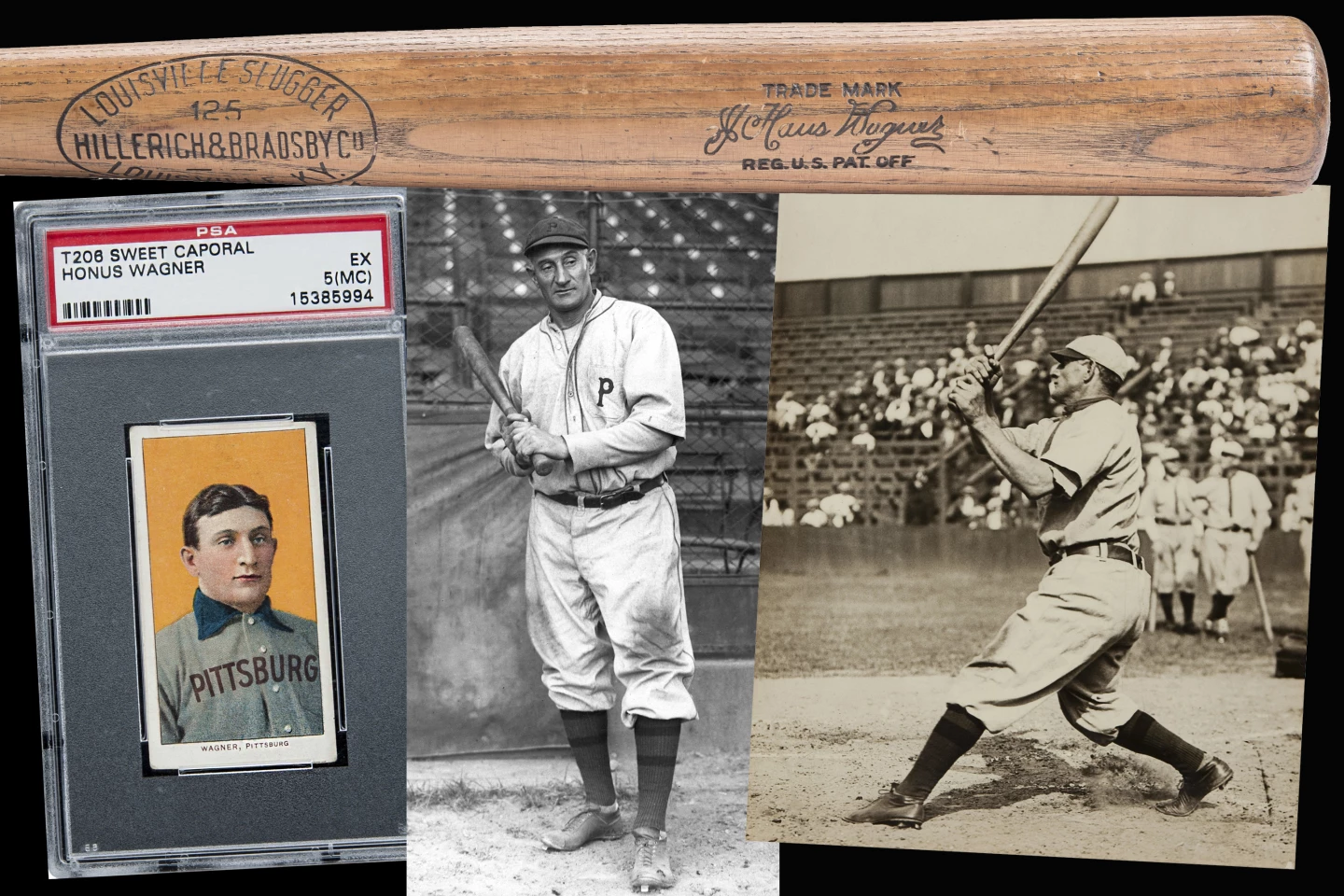
Of particular note is the predominance of baseball bat manufacturer Hillerich & Bradsby. We thought Ferrari dominated the collectible car category by always maintaining more than 50 of the cars in the top 100 most valuable cars sold at auction, but Hillerich & Bradsby has always had the entire top 10 to itself, and more than 95 of the top 100 most valuable bats on the planet. Hillerich & Bradsby pioneered sports celebrity endorsement (paying sportspersons for endorsing their products) and numbered all of the all-time great candidates on their payroll until recently.
As most serious game-used bat collectors are aware, ballplayers for decades assured themselves a lasting supply of ideal game-day bats by returning their favorites to the Hillerich & Bradsby factory for meticulous duplication, where that beloved lumber was cataloged with grease pencil notations, identifying the player and date of receipt. In the parlance of the baseball memorabilia collector, these bats are known as "sidewritten" bats, and this close collaboration between the players and the company that built the tools of the trade enabled that dominance. Sterling performance, Hillerich & Bradsby! Bravo!
The Babe still rules
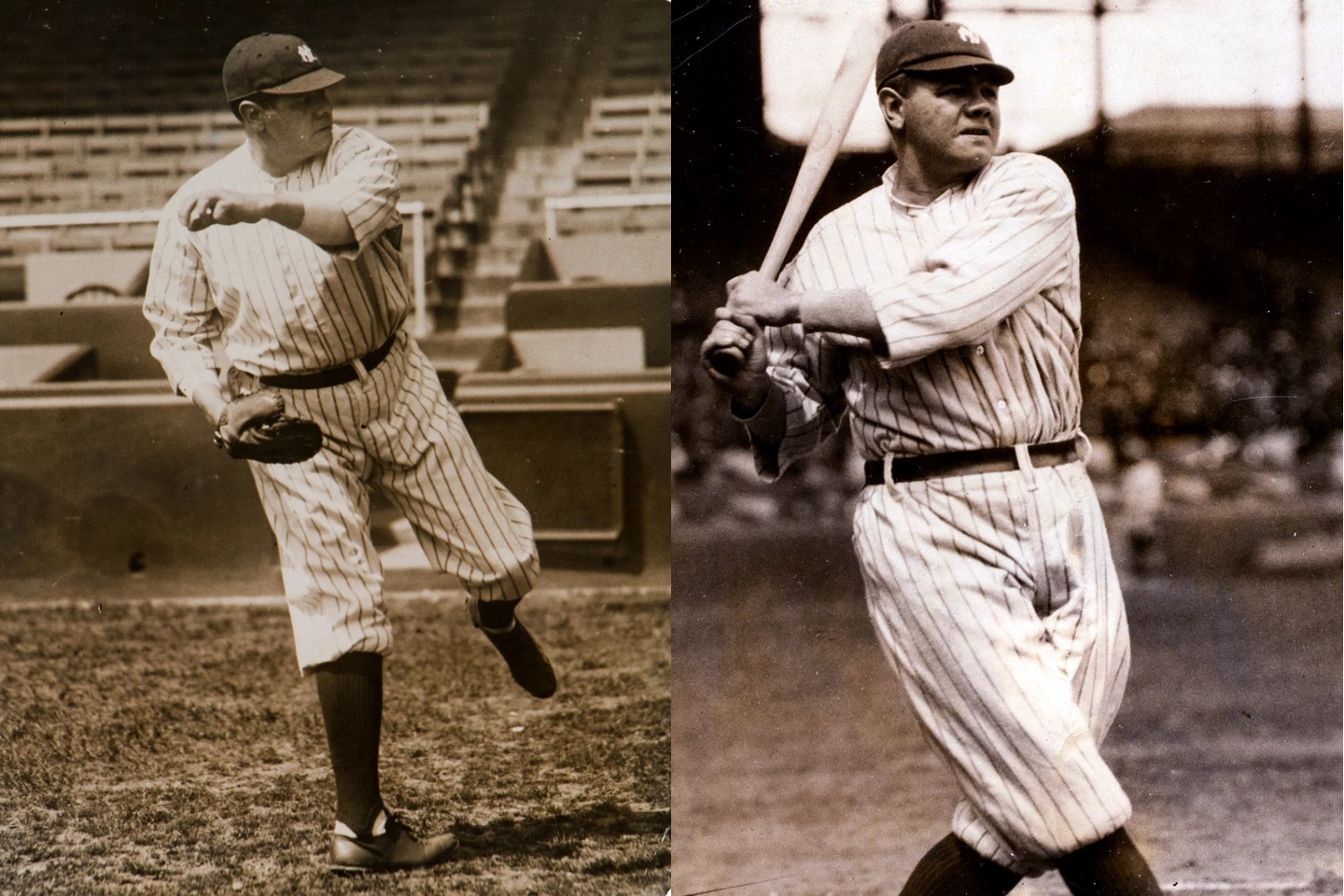
The most remarkable aspect of this research is the overwhelming presence of George Herman Ruth Junior. Still recognizable by the general population 100 years after his prime as "the babe", "the bambino" or "the Sultan of Swat", Babe Ruth is responsible for almost half of the top 25 most expensive baseball bats, and more than 20 percent of the top 100 most expensive items of sports memorabilia ever sold.
While baseball bats might seem like the obvious memorabilia for the biggest hitter in baseball history, Babe Ruth's jerseys have also sold for $4,700,000 and $4,415,658 (and $1,056,630, $771,096, $657,250 ad infinitum), his contracts have sold for $2,303,320 and $1,007,250 (and $996,000 and $537,750 ad infinitum), his 1927 World Series Ring sold for $2,093,927, a home run baseball he launched during the 1933 All-Star Game sold for $770,000, several versions of his numerous baseball cards have sold for more than half a million, his gold pocket watch from his final Yankee Stadium appearance in 1948 sold for $650,000, and he holds similar status in the all-time baseball cap prices at auction (with a high of $537,278).
Whether that’s star quality on a level far beyond any other athlete in the history of sport, or Ruth’s dominance on the auction block has been superficially boosted by the inexplicable dominance of baseball in the sports memorabilia category, is up for debate. The forensic authentication of baseball memorabilia is a factor, but surely cannot be the entire explanation for the astronomical prices fetched by baseball memorabilia in general and baseball cards in particular.
Baseball is much bigger than Babe Ruth, but he has an inexplicably disproportionate share of the top end of the baseball memorabilia market.
Either way, Babe Ruth dominates the baseball memorabilia category, and baseball memorabilia accounts for more than 80 percent of the top 100 most valuable items of sports memorabilia ever sold. From what we can see, that domination continues far beyond the top 100. A prime example of this is immediately available by comparing this listing of baseball bats with their equivalent in all other globally-played sports.
Baseball bats versus hockey stick, cricket bats and golf clubs
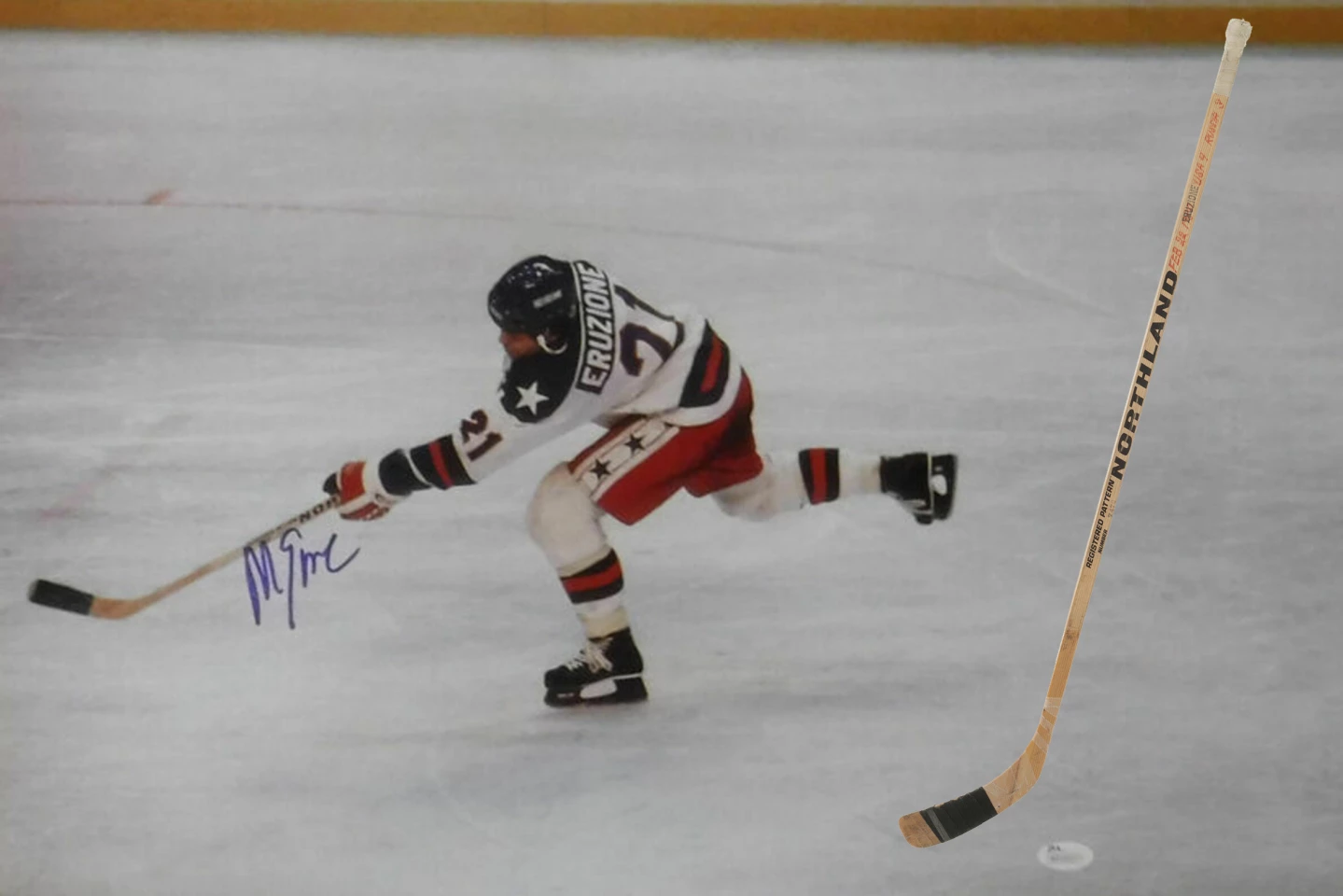
The most valuable hockey stick ever sold at auction was used by American Captain Mike Eruzione to score the winning goal in the final moments of the medal-round game during the men's ice hockey at the 1980 Winter Olympics: the fabled "Miracle on Ice" game. In one of the greatest upsets in world sporting history, the stick that was so central to the miracle became a powerful national symbol and sold for $262,900 – a multiple of the price of the second most valuable hockey stick ever sold.
Cricket is a sport watched and played by many more people than baseball. India alone has 1.5 billion people and they worship the champions of the country’s national sport. The most that has ever been paid for a cricket bat at auction or otherwise, was paid at a charity dinner in London in July 2011. Sports memorabilia’s value is directly proportional to the importance of the moment in which it played a part, and in Indian cricket, there was no more important a moment than the World Cup final on April 2, 2011. No host nation had ever won the World Cup, but from the moment he became India’s captain, Mahendra Singh Dhoni showed leadership beyond anyone prior, delivering on cue whenever it was required, guiding the team from behind the stumps in his role as wicketkeeper and giving backbone to a frail batting middle-order.
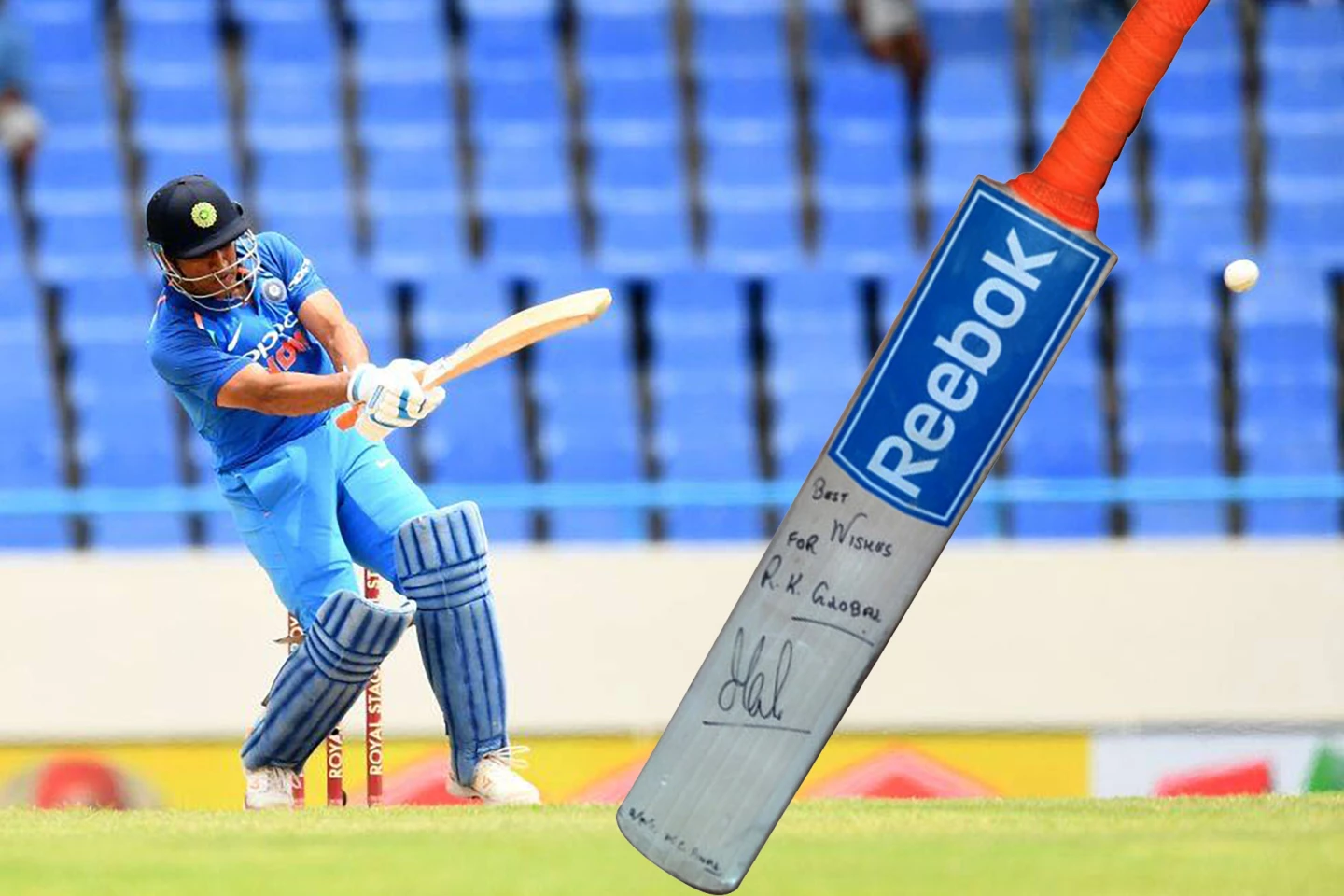
In the World Cup final, with an astonishing 64.6 percent of all the television sets in India tuned to the game, India stumbled early in chasing the record total required to win. Dhoni promoted himself up the batting order and hit 91 runs off 79 balls, striking the ball into the crowd to win the world championship for his country with 10 balls to spare. Dhoni is the only captain to have won all three cricketing world championship trophies (T20 WC, 50-over WC and ICC Champions Trophy). His Facebook page has 21.6 million followers.
Despite all that, Dhoni’s bat sold for just £100,000 ($161,295). Though it now holds a place in the Guinness World Records, and is by far the most expensive cricket bat to have sold at auction, that price would not give it a place in the top 100 most expensive baseball bats.
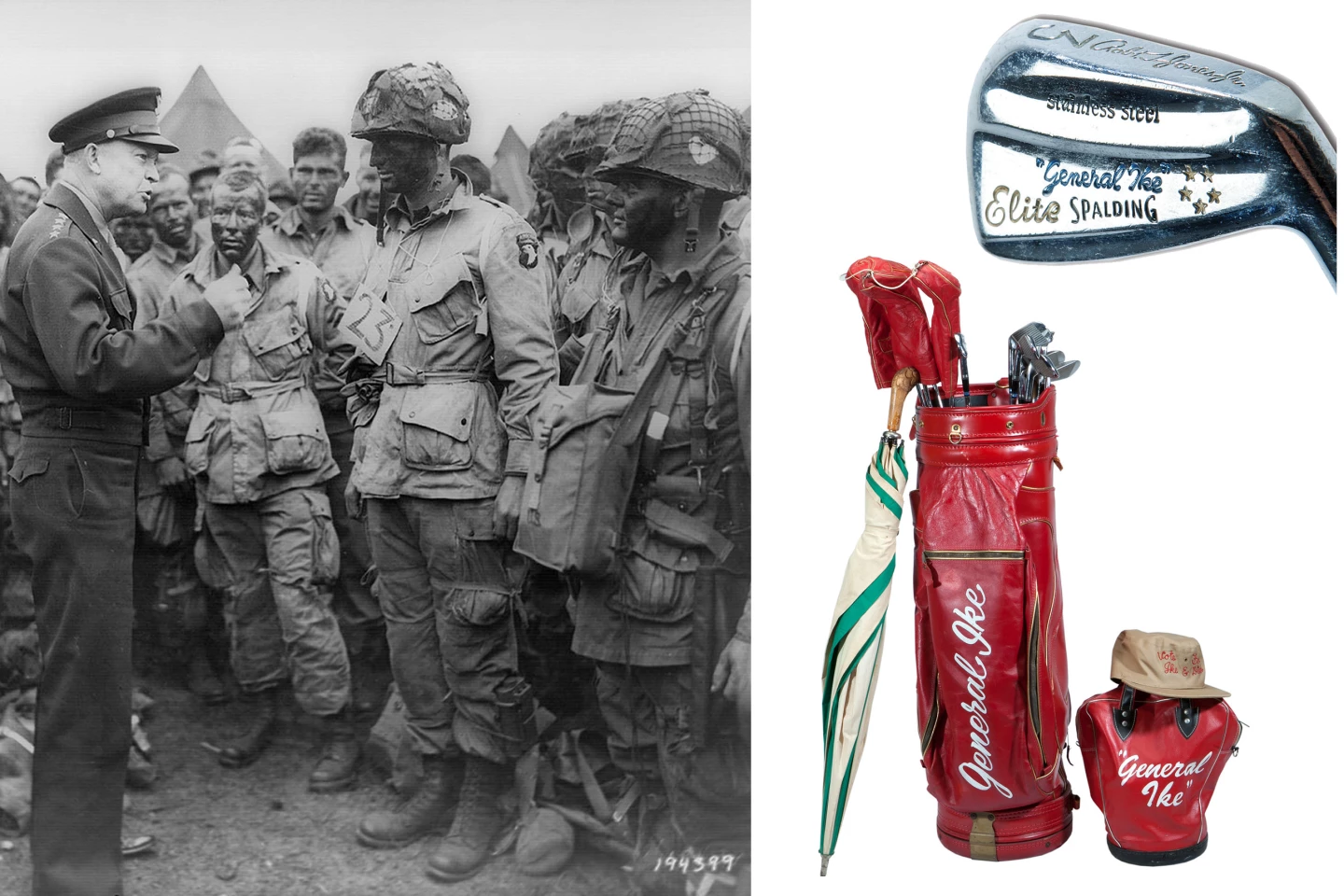
Golf is another game that attracts a massive and monied global audience. It has a history that reaches backwards into time far further than baseball, it’s the only game you will routinely see heads of state and captains of industry playing (often together), and the number of significant commercial agreements reached on the golf course would probably outweigh any other venue, perhaps including the boardroom.
Dwight D. Eisenhower was the Supreme Commander of the Allied Expeditionary Force in Europe during WW2, and went on to become the 34th President of the United States from 1953 to 1961. Eisenhower loved his golf, and had a custom golf bag and a full set of Spalding clubs engraved "General Ike" (Serial #1AAAAAA) which he kept at Augusta. When sold by SCP Auctions in 2015, the clubs fetched $121,122.
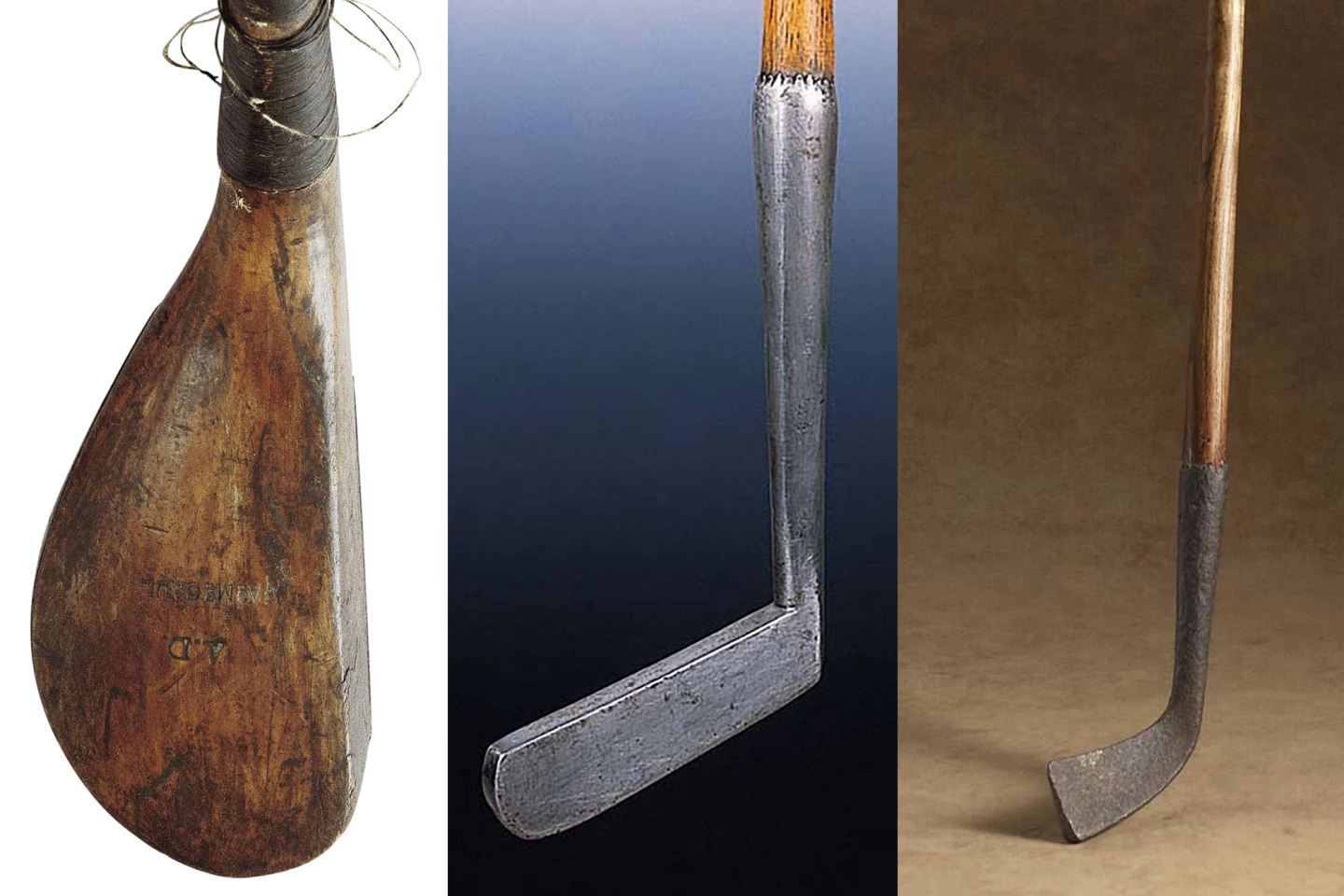
The most paid for a single golf club was a long-nosed putter dated from the 1700s and believed to have been made by Andrew Dickson. It was exhibited at the 1901 Glasgow International Exhibition and was sold by Sotheby’s in New York in 2007 for $181,000.
Unlike the cricket bat and hockey stick mentioned above, which were outlier auction results compared to similar objects sold at auction from those sports, there are a number of golf clubs that have been sold for just a little less than the most expensive price.
Exactly why baseball holds such a reverent place in the minds of the world’s sports collectors and enthusiasts we do not know, but the most expensive cricket bats, hockey sticks or golf clubs ever sold would not get a spot in the 100 most valuable baseball bats sold.
Here is our list of the 10 most expensive baseball bats:
10 | c. 1917-21 Hillerich & Bradsby Baseball Bat, PSA/DNA GU 7
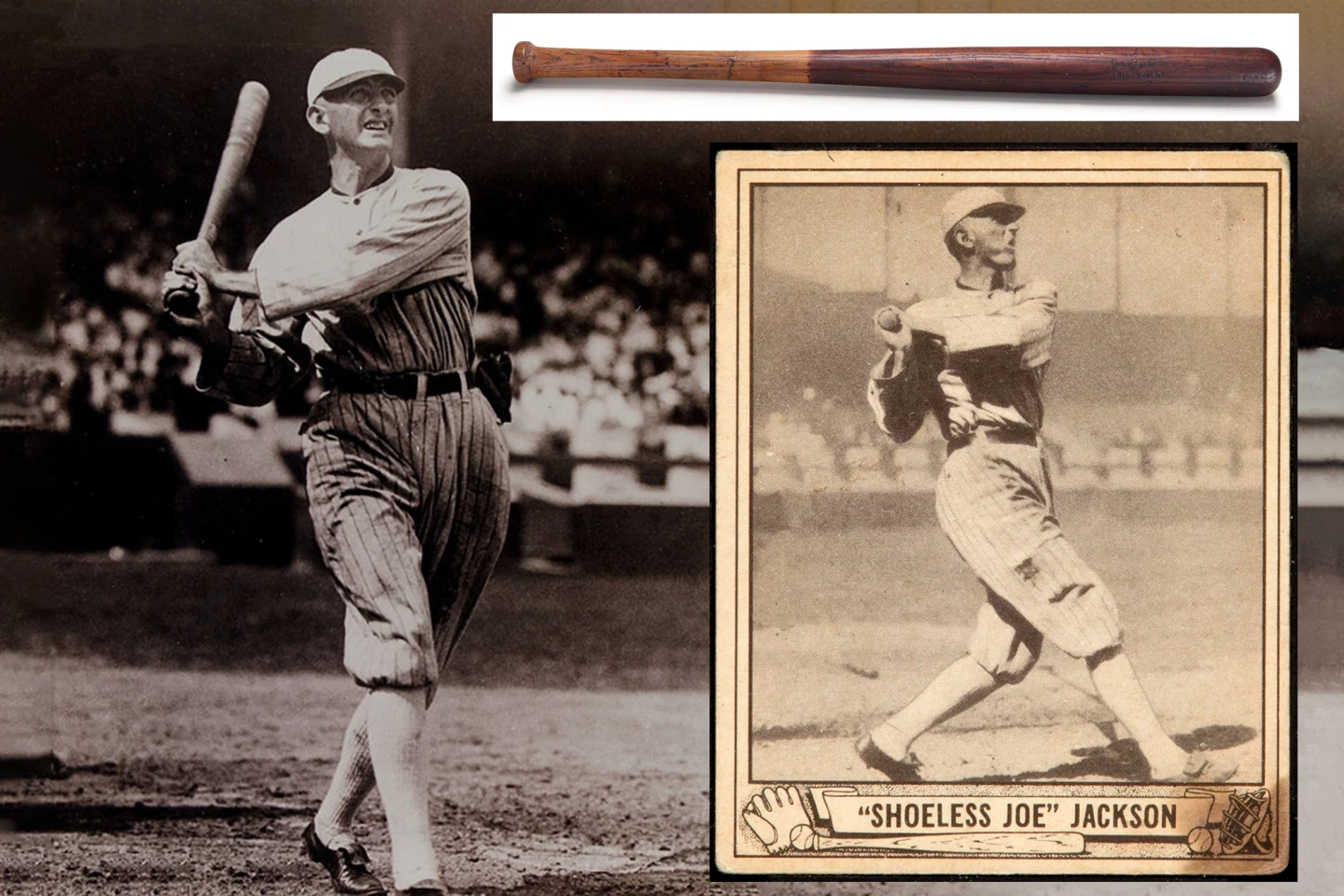
Price: $583,500
Game-used by: “Shoeless” Joe Jackson
Auction House: Christie's
Auctioned: October 20, 2016
Provenance (from the Christie’s Auctions catalogue description and from a Hunt Auctions catalogue description for another Joe Jackson bat on this list): Babe Ruth once remarked, "I copied Jackson's style because I thought he was the greatest hitter I had ever seen, the greatest natural hitter I ever saw. He's the guy who made me a hitter."
As Ruth's words illustrate, "Shoeless" Joe Jackson (1887-1951) was regarded by his peers as one of the greatest pure hitters in the game. During a relatively brief 13-year career, Jackson amassed over 1,700 hits, a .517 slugging percentage, and hit for a lifetime average of .356, which ranks as the third highest in Major League history.
Infamously, Joe Jackson was banished from Major League Baseball by Commissioner Kennesaw Mountain Landis along with seven other White Sox players after being implicated in fixing the 1919 World Series. Although the repercussions remain the same, the general consensus along baseball historians is that Jackson in fact did try his best during the 1919 World Series (batting average of .375).
Whether or not Joe Jackson merits enshrinement into the National Baseball Hall of Fame is certainly open to debate. The fact that he was one of, if not the greatest pure hitters in the history of the game, is not.
The legendary slugger played for the Chicago White Sox from 1915-1920 during the period this bat was manufactured. It is one of two known professional model Joe Jackson bats, and the only full name script Signature model manufactured by Louisville Slugger that can be attributed to being used by Jackson. The Hillerich & Bradsby bat is a "Pre Model number" bat dating from the 1917-21 labelling period, with the signature "Joe Jackson" emblazoned upon the barrel. This bat exhibits outstanding use with a substantial handle crack, repaired drying or grain swelling on the front and left barrel, ball marks on the right, left and back barrel, cleat marks, scoring on the handle to enhance grip, and some fading to the finish on the front barrel.
The bat features Jackson’s dark barrel and natural handle, characteristic of his "Black Betsy" finish. For the record, Jackson's legendary "Black Betsy" bat sold back in 2011 for $537,750 at Heritage Auctions, and is another that would join the Million Dollar Club Club if it were to appear at auction today. Authenticated and graded by PSA/DNA GU 7. Length: 35.5 in (902 mm). Weight: 39.2 oz (1,111 g).
9 | 1927-28 Hillerich & Bradsby Baseball Bat, PSA/DNA GU 10
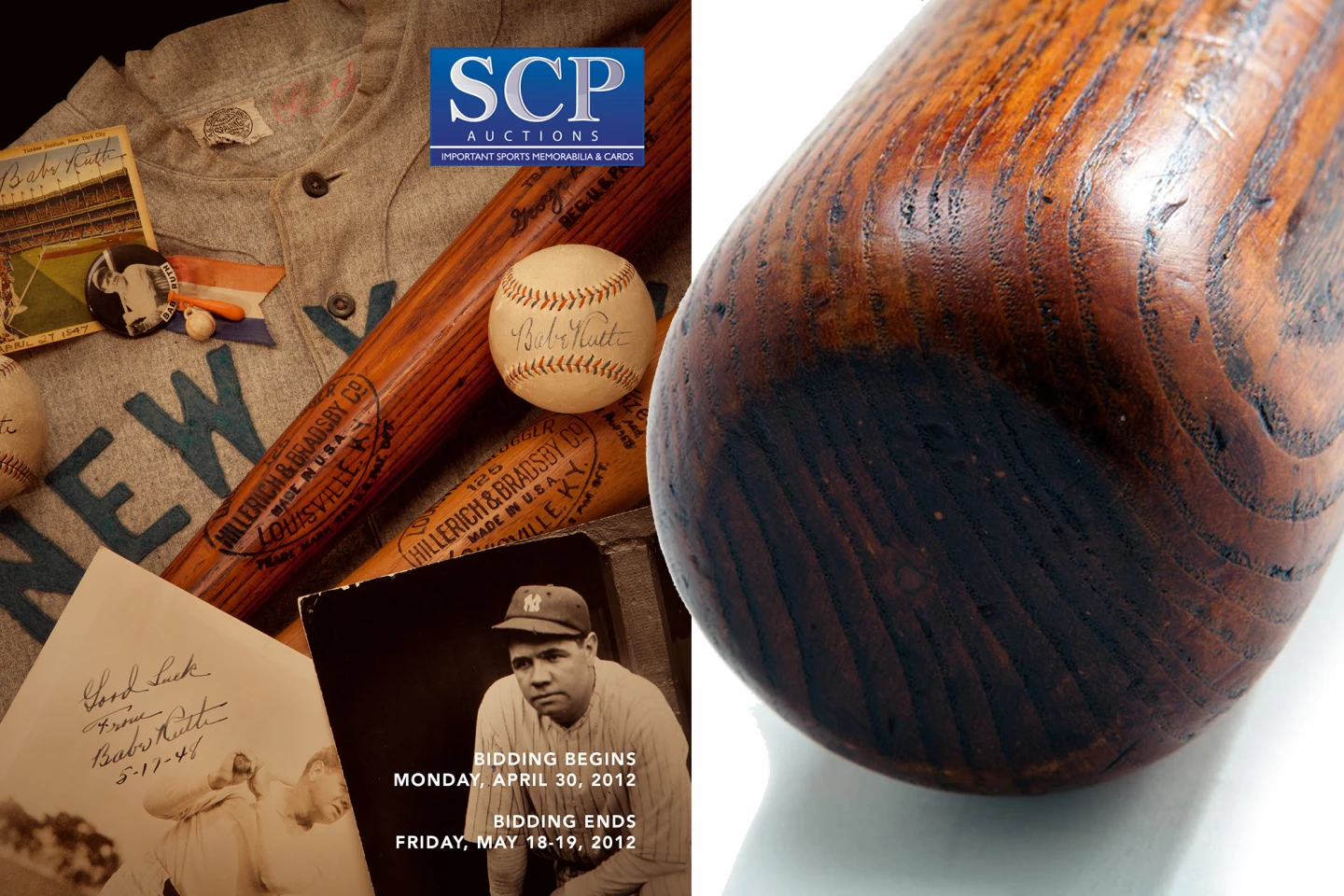
Price: $591,007
Game-used by: Babe Ruth
Auction House: SCP Auctions
Auctioned: May 20, 2012
Provenance (from the SCP Auctions catalogue description): Babe Ruth played baseball like he lived life: with loud, gaudy, entertaining gusto. There was nothing subtle about the happy-go-lucky Sultan of Swat, who paraded through his career, forged an enduring relationship with adoring fans and then withstood the test of time as the greatest power hitter in baseball history. Ruth's legendary home run totals – 714 in his career, 60 in 1927 – are no longer records, but they still stand as milestone numbers by which all power hitters are judged. His legendary carousing still enhances the irascible image that colors his aura. More than anything, the magnetic Ruth is hailed as the saviour of the game, the man who ushered in the longball era and revitalized baseball when it was mired in the bog of the 1919 Black Sox scandal.
Ruth became a New York icon as he powered his way through the Roaring '20s and the Great Depression, posting shocking homer totals of 59 (1921), 60 (1927) and 54 (1928) while leading the Yankees to four World Series championships and anchoring one of the most devastating lineups in history. Lost in the fog of Ruth's 12 American League home run titles, 13 slugging championships, four 50-homer seasons, and six RBI titles was a career .342 average that still ranks 10th all time.
No single sports memorabilia item consistently inspires more awe than a bat used by Babe Ruth. For veteran hobbyists or casual fans, the allure of a bat wielded by Ruth in his prime, the ultimate tool of his trade, is unfailing. For many reasons this example is among the finest of known Ruth gamers. The first is that it dates to the 1927 period during when Ruth was at the peak of his slugging prominence. The second is the combination of ideal usage traits and a breathtaking state of preservation. Lastly, is the ironclad provenance provided by the H&B "R34" factory vault mark it bears on the knob. This R34 vault mark identifies this as the model bat ordered exclusively by Ruth from May 14th, 1927 thru March 8th, 1930. It was the model used by the Babe in 1927 to establish what was then the single season home run record of 60 home runs.
Babe Ruth's Professional Bat Ordering Record (PBOR) from Louisville Slugger Inc. documents that the R34 vault mark was applied to this bat on May 8, 1930. This is also the date the bat was returned to the factory by Ruth. It was common practice from the teens to the mid 1940's for players to return their bats to the factory so that more of the same model could be shipped to them. Upon receipt, most bats were inscribed with the return date, the bat's length and weight, player name and team affiliation. In this case, the bat is not sidewritten, but vault marked. Knowing that the vault mark was applied to this bat on May 8, 1930, we know Ruth used it between 1927 and 1930.
The 35-inch (889-mm), 38-oz (1,077-g) war club shows evidence of outstanding use with a small handle crack. The left barrel shows evidence of ball contact and bears several cleat marks as well. Setting aside the bat’s desirable technical attributes, its aesthetic quality is extraordinary. The ash wood grain, rich amber coloration and fine patina are marvelous. Deeply-rendered factory centerbrand and barrel markings complete a perfect package of every desired attribute sought by fastidious bat collectors. This magnificent artefact is an elite class of surviving bats wielded by the "Sultan of Swat" and would be a cornerstone in the finest baseball memorabilia collection in the world.
8 | c.1919-20 Hillerich & Bradsby Baseball Bat, PSA/DNA GU 7
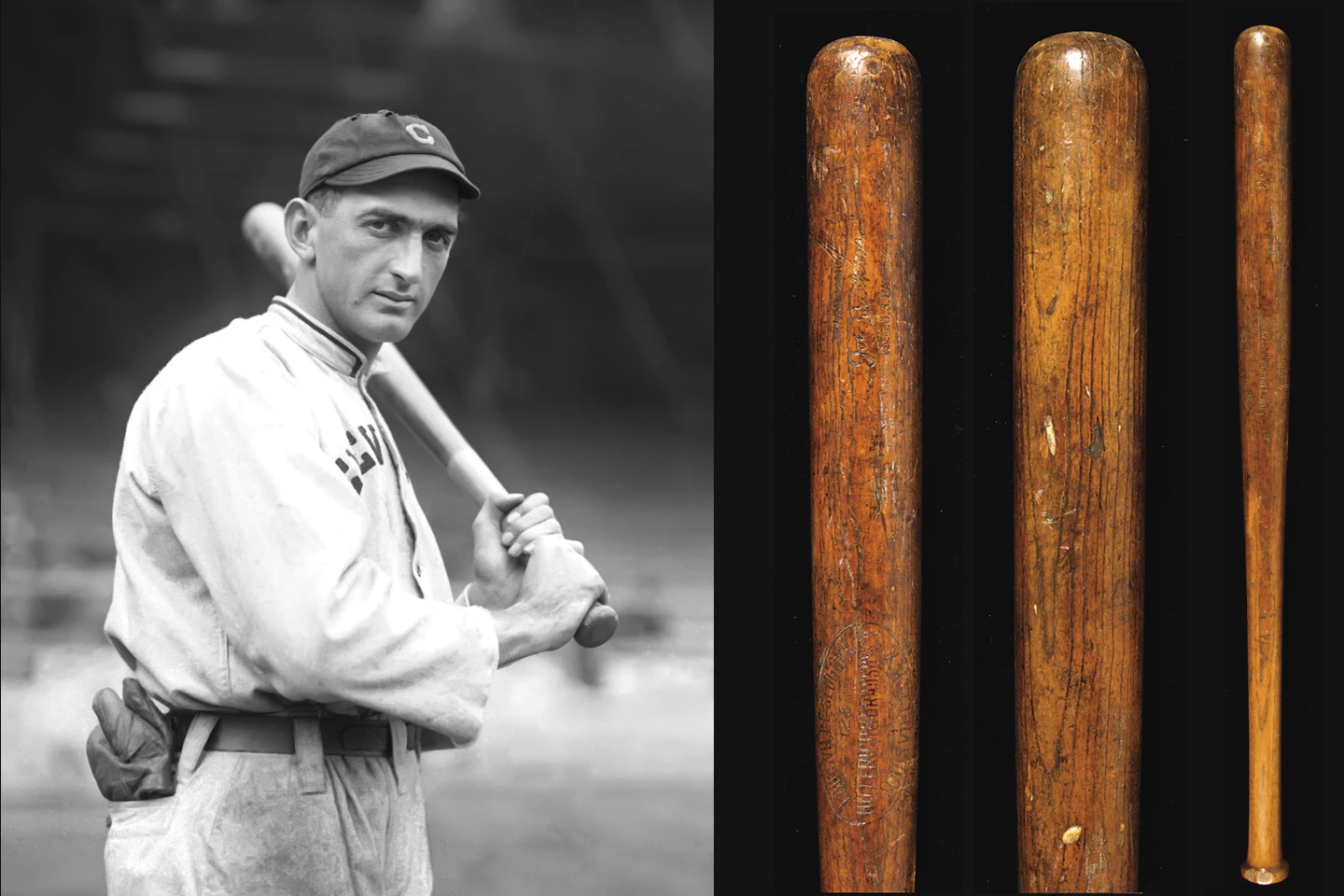
Price: $605,077
Game-used by: “Shoeless” Joe Jackson
Auction House: Hunt Auctions
Auctioned: February 2015
Provenance (from the Hunt Auctions catalogue description): Offered is a truly scarce and historic Joe Jackson professional model baseball bat c.1919-20. Louisville Slugger 125 model bat measures 35.75-in (908 mm) long and weighs 40.6 oz (1,151 g). Very fine evident use is visible throughout including slight grain checking on the back of the barrel from ball contact, ball marks to barrel area, cleat marks, and chipping to the knob area. This particular bat is one of only two such authenticated Joe Jackson pro model Louisville Slugger bats of their type dating to his pre-banishment playing career.
The other exemplar originated from the actual vaults of Louisville Slugger (marked J13) having been returned to the factory by Jackson for purpose of using a model for re-ordering. In comparison to the Louisville Slugger vault marked specimen the specifications for the offered bat are nearly identical each measuring 35.5+ and weighing within 1.4 oz (40 g). The offered bat also shares the same finish as the vault marked J13 model as well. The presence of the full name -Joe Jackson+ signature script impression on the barrel of the offered bat is also of significance as the documented pro model bats used by Jackson post banishment (1920) feature only the last name "Jackson" on the barrel. As referenced within the PSA/DNA letter, John Taube's research in conjunction with Louisville Slugger has confirmed that full name -Joe Jackson+ pro model bats were not produced for use after the 1920 banishment date.
Although the very specific reasons for this production change are not confirmed it is agreed upon that the reasoning was related to Jackson's banishment from baseball. The origins of the bat are appropriately entrenched within a lifelong "baseball family" tracing its roots within the game over 90 years ago. Jack Bloomfield was a former professional baseball player, coach, and scout for over 50 years. Jack's father, Alfred Bloomfield, played semi-professional baseball from the mid 1910s through the 1920s; he was offered a contract but had to go back and work on the farm.
Additionally, Jack's uncles also played semi-professional baseball. Jack's brother was offered a contract with the St. Louis Browns, but had to turn it down since he was newly married. Alfred Bloomfield was born in 1895 is Southeastern Missouri. Alfred is well documented within family archived photographs and articles to have played on several semi-professional baseball teams during the mid 1910s period into the 1920s. It was during this time period that Alfred Bloomfield acquired the Joe Jackson bat presented within this auction. Alfred traded a fellow player a new first baseman's mitt along with some money for the Jackson bat which, at the time, was a princely amount.
Bloomfield clearly understood the place which Joe Jackson held within the history of the game even after having been banished, and as such was willing to part with the un-characteristically high price for the time period. Bloomfield himself relayed to family members that the bat had been acquired directly from Jackson himself by another player while barnstorming against a semi-pro team. The bat was retained by Alfred Bloomfield and descended within his family until its current offering by his son, Jack. The very scarcity of this particular Joe Jackson full name professional model bat cannot be overstated numbering as one of two extant. Its impeccable primary source provenance within a lifelong professional baseball family further corroborates the succinct and self-attributable factual information provided by the bat itself.
Markings which precisely date to the 1919-20 (combination of 1919-22 C-3B center brand stampings and full name Joe Jackson stampings) era in which Joe Jackson played for the Chicago White Sox and quite possibly again during his post banishment barnstorming games.
Furthermore, based on Louisville Slugger factory records we can confirm that Joe Jackson pro model bats were not made available to the general public. Based on the aforementioned conclusions and accompanying provenance we feel confident in ranking the offered bat among the very finest game bats ever offered at public auction. The unique place which Joe Jackson holds within baseball lore coupled with his status as one of the greatest batsman in the history of the game creates a consistently growing demand for related items of significance.
7 | 1927 Hillerich & Bradsby Baseball Bat, PSA/DNA GU 10
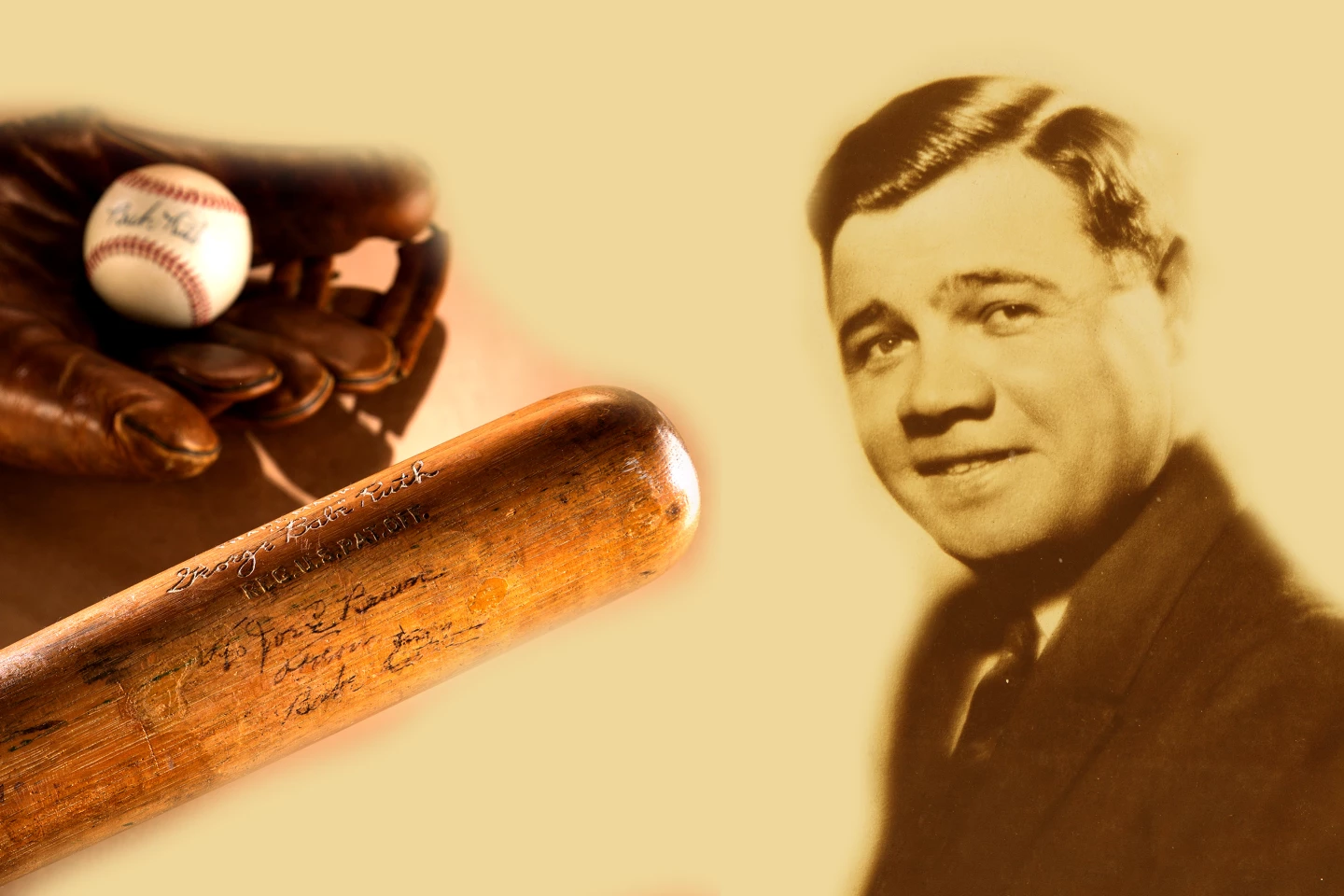
Price: $660,000
Game-used by: Babe Ruth
Auction House: Heritage Auctions
Auctioned: May 18, 2018
Provenance (from the Heritage Auctions catalogue description): It has been 117 years since the franchise that would become the New York Yankees took its first breath, just a few miles and six years removed from the place and time where an infant who would become Babe Ruth took his own. By 1903, the Baltimore Orioles had become the New York Highlanders, and then, after another decade and its relocation to the famous Polo Grounds, the team was officially rechristened with the name that appears on all twenty-seven versions of its World Championship hardware.
It is no revelation to pronounce the expensive arrival of that boy from Baltimore as the primary catalyst for the Yankees' rebranding as the gold standard of American sport, a theme that endures as we edge toward the centennial of Ruth's acquisition from the Boston Red Sox. Since that 1920 transaction, no decade of Yankees history but the 1980's has ended without at least two celebrations of Fall Classic glory.
It's a chart of far more peaks than valleys. The highlight reel of timeless moments is a feature-length film at this point, the cast of Hall of Fame immortals large enough to fill a city bus. But if we were to survey the entirety of that range to locate the Everest of Yankee greatness, that highest peak of the franchise Himalayas, the offered relic might well be the marker we'd find there.
First, let's acknowledge the obvious. Ruth's 60 home runs in 1927 is no longer the record. Maris has long since shed his asterisk, and the millennial power surge either clarified or muddied the waters depending on one's personal standards for fair play. But context is everything, and clearly there are oceans separating the various Home Run Kingdoms.
That being said, we feel no compulsion to beat baseball's deadest horse. Roger Maris was a man of his age. Mark McGwire and Barry Bonds were men of their own. Babe Ruth, however, was unquestionably something different, a full paradigm shift, the prime resuscitating force that closed out a half century of the Dead Ball Era. His sixty home runs in 1927, a thrilling improvement of his own towering record, could quite properly be identified as Ruth's greatest masterpiece.
The team to which he supplied that unprecedented offensive onslaught likewise stands alone atop the ranking of nearly every baseball historian, an unstoppable force immortalized with the homicidal nickname of "Murderer's Row." That killer crew would send the Pittsburgh Pirate ship to Davy Jones' Locker that year in a merciful four-game Fall Classic sweep, the conclusion coming just eight days after Ruth raised his storied record.
That second World Series Championship in franchise history was a glorious achievement, to be sure, but we'd consider it somewhat of an anticlimax after September 30, 1927, when the Babe made it an even five dozen. We are extraordinarily proud and privileged to present to the collecting community the bat with which Babe Ruth struck his fabled sixtieth.
It is essential that we disclose the fact that the Baseball Hall of Fame-an establishment for which we hold the utmost respect--claims to own the bat responsible for that monumental feat. But the detailed letter of examination from leading expert John Taube of PSA/DNA carefully compares and contrasts the divergent tales of provenance, leaving little doubt that the Cooperstown example is improperly identified.
Both bats can be definitively assigned a 1927 vintage, the offered hickory model, measuring just under thirty-five and a half inches (35.375") and thirty-nine ounces (38.8 oz.), delivered to Ruth as part of a Hillerich & Bradsby order placed between May 14 and September 27 of that year. The outstanding game use evident here suggests the bat served a lengthy tenure in the hands of the game's foremost slugger, with multiple ball marks and stitch impressions on the left barrel, matching Ruth's label-down, left-handed swing. Green rack streaks decorate the barrel and handle. The right barrel is inscribed in black fountain pen ink "To Joe E. Brown From Babe Ruth."
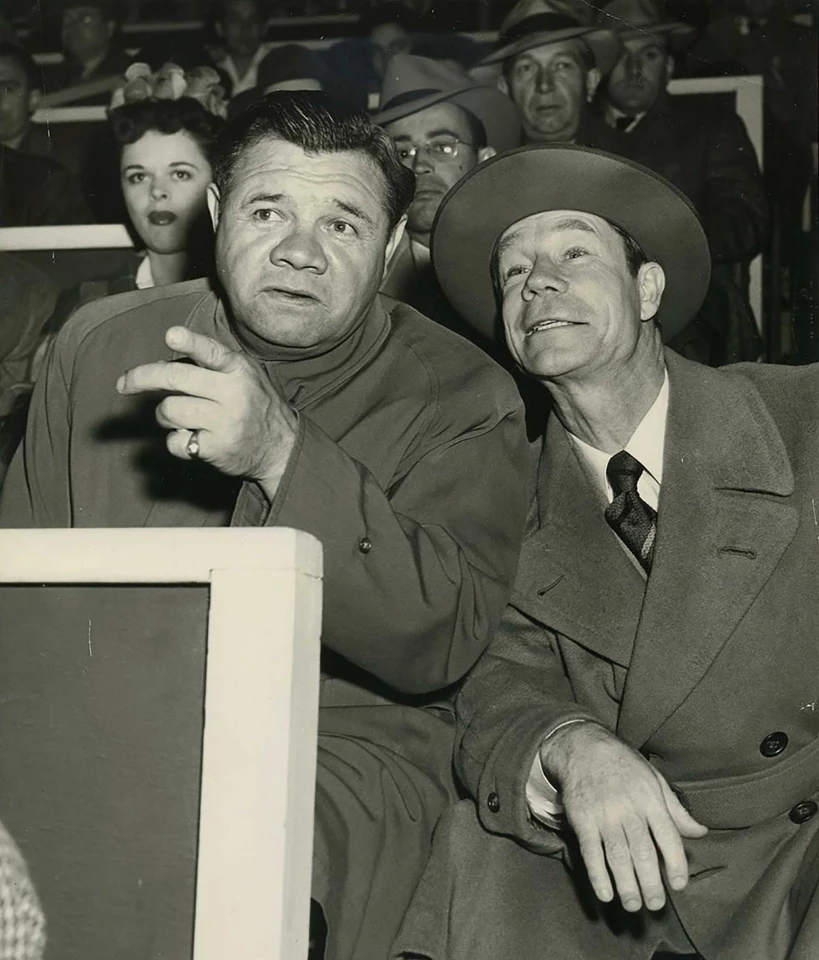
That name will be familiar to most veteran hobbyists, as Brown was a famous and much beloved comedian and movie star widely regarded as the first celebrity sports memorabilia collector. Brown nearly had a Major League career of his own, but traded the diamond for vaudeville and the silver screen after a broken leg hobbled his chances for athletic glory. His collection included uniforms from Cobb, Wagner, Speaker and Foxx, and the bat with which Babe Ruth clubbed his three home runs for an ailing Johnny Sylvester in the 1926 World Series, though tragically most of that collection was lost in the 1961 Los Angeles wildfires. Bill Mazeroski's most famous long ball saved this relic from that scorched fate, as Brown had gifted to it his son, Pittsburgh Pirates general manager Joe L. Brown, in celebration of his team's 1960 World Championship. A notarized 2012 letter from Don E. Brown-son of Joe L. and grandson of Joe E.-discusses the history of the collection, and of this bat in particular.
The Babe's established friendship with Brown, and the documented history of presenting him with a bat of supreme significance (the 1926 Johnny Sylvester gamer), serve as a convincing validation of the younger Brown's sworn affidavit. The bat is also referenced in a pair of included (copies) news articles. The June 23, 1941 edition of "The Montreal Gazette" article entitled "Joe E Brown Trophies, Ball Museum Pieces" identifies his ownership of "the bat used by Babe Ruth...when he set the still unbroken record of 60 home runs," mistakenly listing the vintage as 1931.
The December 1948 edition of "The Sporting News" supplies the first acknowledgment of the competing narratives in an article entitled, "Controversy Over Historic Ruth Bat," documenting Brown's public comments to a banquet crowd which contained the source of the other purported example, "New York Sun" baseball writer Jim Kahn. Kahn was quoted to respond, "I have no wish to start a controversy, but I want to state that the bat which is now on exhibition in the Baseball Museum was given to me by Babe after he hit his sixtieth home run."
This statement by Kahn is one of several points of concern.
An included copy of a June 1939 article from "The Otsego Farmer," the local paper for Cooperstown, discusses Kahn's gift to the Hall of Fame, noting, "Mr. Kahn was then, as now, a baseball writer traveling with the Yankees, and the bat was given to him by Miller Huggins." While some might dismiss the inconsistent reporting of the identity of the presenter of the bat to Kahn, the suggestion that Ruth would have parted with the bat with one last regular season game and the World Series still ahead--or that he would have made a lowly sportswriter the beneficiary of such a monumental treasure – certainly strains credulity.
The Babe was fiercely protective of his historic bats, and there is nothing in the public record to suggest that his relationship with Kahn was anything more than casual, in sharp contrast to his close friendship with Brown. Furthermore, Ruth had a long-established record of presenting historic home run bats to personal friends and dignitaries, always personalizing them to the recipient above his signature. The Brown bat is personalized, while the Kahn bat is not.
Taube likewise references a tale recounted in Robert Creamer's definitive Ruth biography, "Babe: The Legend Comes to Life," about Ruth's staggering late-season hot streak-seventeen home runs in September. Eight days before he broke the record, the superstitious slugger walked it off against the Tigers with a two-run blast in the bottom of the ninth-number fifty-seven on September 22nd--and ran the bases carrying his bat out of fear that one of the celebrating fans storming the field might make off with it as a souvenir. So would he have simply given away the best bat of them all a week later, before the season was over? All logic would suggest otherwise.
We invite you to study the evidence yourself – the full dossier will be made available for review at our online lot listing – and make your own determination. We expect most, if not all, will reach the conclusion shared by the experts at PSA/DNA and Heritage Auctions – that this offering is the one and only authentic 1927 Babe Ruth 60th home run bat, and thus one of the most significant articles of sports memorabilia ever to cross the hobby's auction block.
6 | 1921 Hillerich & Bradsby Baseball Bat, PSA/DNA GU 10
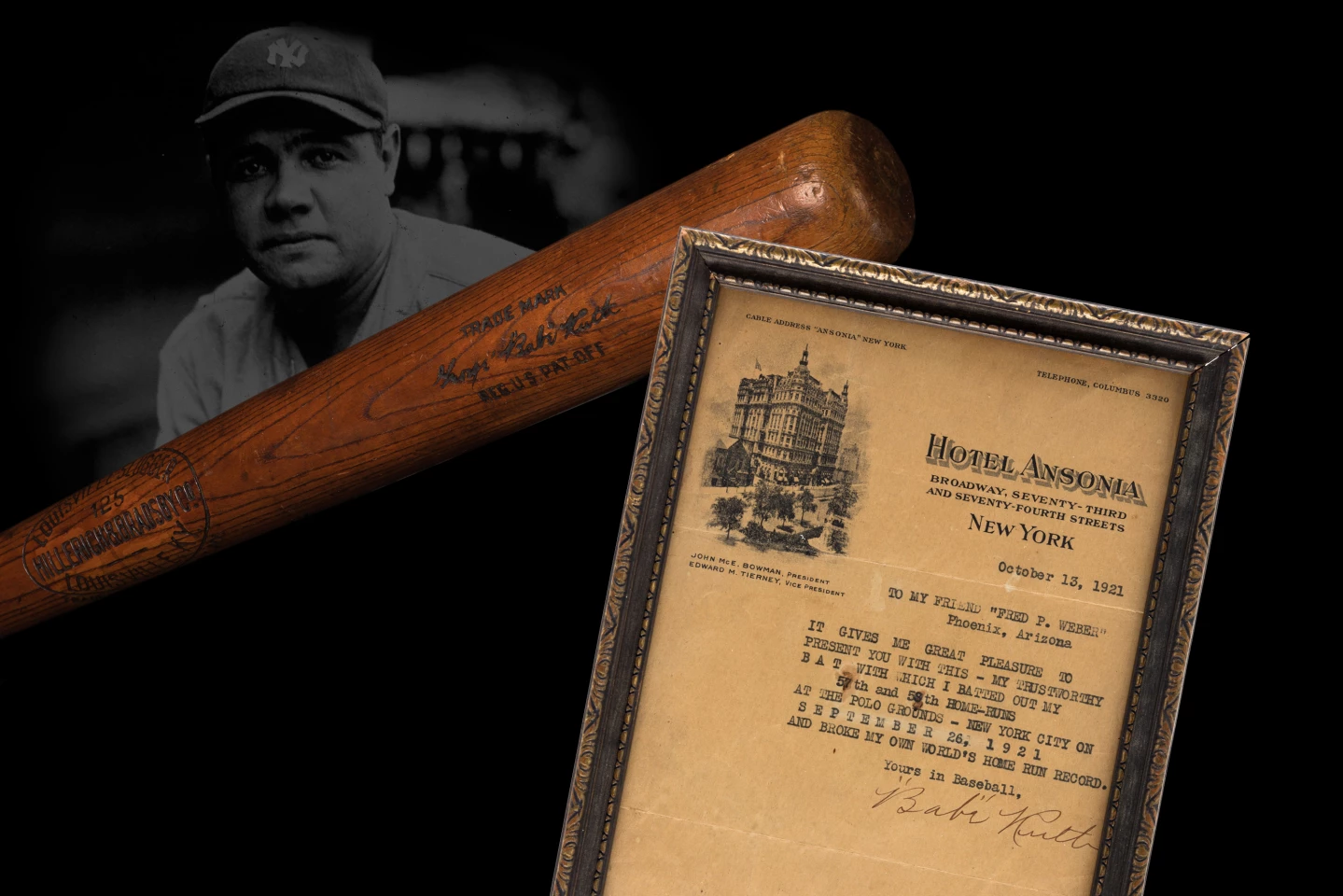
Price: $717,000
Game-used by: Babe Ruth (Personally Documented Home Run Bat Attributed to Record 59th of the 1921 Season)
Auction House: Heritage Auctions
Auctioned: February 22, 2015
Provenance (from the Heritage Auctions catalogue description): "I wish him all the luck in the world," Yankees teammate Frank "Home Run" Baker told the press midway through the 1921 season. "He has everybody else, including myself, hopelessly outclassed."
Speaking about Babe Ruth, it's likely that the ageing star of Connie Mack's "$100,000 Infield" felt a bit sheepish about his own moniker as he shared a dugout with Ruth, having never put more than a dozen into the seats during any season of his own career. It had taken the Babe just twenty-five games to match Baker's best during that spectacular 1921 season, one commonly considered the finest of Ruth's storied career. By season's end, the Babe would belt at least one 500-plus foot blast in each of the eight American League ballparks.
And so it was not just the frequency but also the impossible trajectory of Ruth's home runs that etched his name ever more indelibly into living American folklore in 1921, and slammed the door forever on the Dead Ball Era. The decadent Roaring Twenties had found its perfect athletic representative, larger than life in every way.
Few sporting relics are as instantly evocative of their original master as the presented signature model Hillerich & Bradsby R2, an impossibly heavy slab of ash just a quarter-inch shy of a yard in length (35.75") and an ounce shy of three pounds in weight (47 oz.). In the rudimentary physical equation of force equals mass times speed, we find the first clue to the puzzle in the bat's wrist-straining heft, at forty-seven ounces the weightiest Ruth gamer ever to cross the hobby's auction block.
Leading bat expert John Taube assesses the game use as "excellent," noting several prominent ball marks on the left barrel, correct for Ruth's label-down batting stance, and cleat marks throughout. Defined lathe marks appear on knob and barrel end. Center brand and barrel stamping are deeply burned and flawless. The bat retains its original finish, which has aged beautifully and today exudes a rich mahogany tone.
The letter is typed on the letterhead of the Hotel Ansonia on the Upper West Side of Manhattan, the home of not just Ruth but also fellow Yankees Wally Schang, Lefty O'Doul and Bob Meusel. The hotel had a well-earned reputation in those days for hedonism, drawing a mix of gamblers, athletes and socialites from reigning Heavyweight Champion Jack Dempsey to Florenz Ziegfield, the biggest name in burlesque. It was in Chicago White Sox first baseman Chick Gandil's room at the Ansonia that the conspiracy to throw the 1919 World Series was born.
And it was here that the Babe, who often roamed the corridors in a silk robe as if the entire building were merely an extension of his personal suite, made the acquaintance of brothers Harry and Fred Weber, the former serving as Ruth's booking agent for vaudeville engagements prior to the emergence of Christy Walsh. A New York Times article dated October 28, 1921 reports on the profitable relationship:
"The home run king will take his first turn at bat as a thespian in the Keith Theatre in Boston on Monday, Nov. 7...Ruth's contract with the Keith organization calls for twenty weeks at the modest salary of $3,000 per week. At the signing of the contract Ruth was represented by Harry Weber, who will manage him during his theatrical career..."
The closing line of the article states: "The Babe has turned over his treasured home run bats and balls to the Keith people for advertising purposes, and they will be featured in the lobbies of the theatres in which he is playing before and during the big league engagement."
It is noteworthy that a nearly identical bat, with a nearly identical letter, resides in Cooperstown at the Baseball Hall of Fame. The small differences between the two letters further assist in identifying the presented model as the one used by Ruth to hit his 59th and final home run on October 2nd, the last day of the 1921 season.
While any bat wielded by the greatest name in baseball history is properly considered an American treasure, it must be stressed that the listed representation finds itself in an elite class that could be enumerated on a single hand. It's unquestionably the most significant Ruth home run bat to cross the hobby's auction block since the one that launched the first home run at Yankee Stadium in 1923 commanded $1.3 million over a decade ago, the heaviest known, and the only example in private hands accompanied by the Babe's own signed letter of provenance.
5 | 1921 Hillerich & Bradsby Baseball Bat, PSA/DNA GU 10
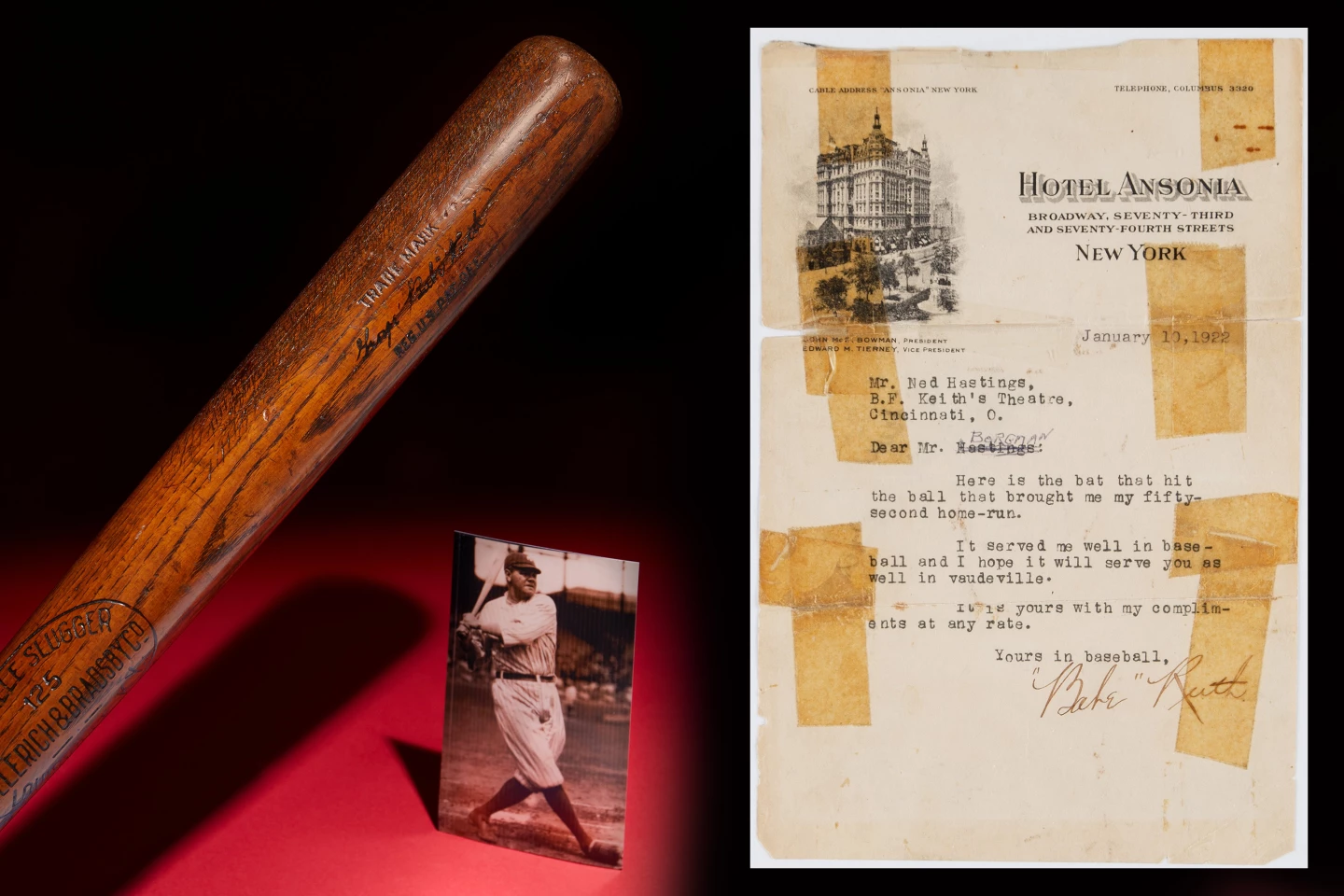
Price: $930,000
Game-used by: Babe Ruth
Auction House: Heritage Auctions
Auctioned: May 9, 2020
Provenance (from the Heritage Auctions catalogue description): Few sporting relics are as instantly evocative of their original master as the presented signature model Hillerich & Bradsby R2, an impossibly heavy slab of ash just an eighth-inch shy of a yard in length (35.875") and a few ounces shy of three pounds in weight (43.2 oz.). To hold this bat, and feel the wrists strain against the pull of gravity, is to experience an instant connection to the man who transformed the game.
Leading bat expert John Taube assesses the game use as "outstanding," noting several prominent ball marks on the left barrel, correct for Ruth's label-down batting stance, and cleat marks throughout. Heavy scoring on the impact surface of the barrel is a perfect Ruth trait. Green streaks acquired as the weapon was sheathed and unsheathed from the bat rack remain visible, and while remnants of black ink on the knob are no longer legible, logic would suggest this was once a notation applied in the dugout to identify the bat's special history.
That history was made in the final month of the Yankees' first American League Championship season, during a visit of the Babe's former Boston Red Sox club to the Polo Grounds. In the second contest of a September 7th doubleheader, Ruth would open the scoring of a seven-to-two victory with a fourth inning, two-run shot off former teammate Herb Pennock, who would rejoin Ruth in the Bronx in 1923, and in Cooperstown in 1948. Ruth would go on to hit seven more before the regular season's conclusion, setting a new record of fifty-nine home runs that he'd famously topple as lead assassin of the 1927 Murderer's Row.
Now firmly implanted as the sport's most famous figure, Babe Ruth effectively innovated a new and enduring trend of transforming his game used gear into coveted keepsakes for his ever-growing fan base. As educated collectors are aware, some of Ruth's most significant surviving game used bats entered the collectibles realm as presentation pieces to accomplished young ballplayers, notably the bat used to launch the first home run at Yankee Stadium.
This particular model was likewise made a trophy for a teenaged slugger, a youngster named Harry Borgman who had been voted the best amateur player in his city in a poll conducted by the Cincinnati Enquirer. As the Babe passed through that city during a post-season vaudeville tour, he personally presented this bat to the star-struck young man. A lengthy notarized 2005 letter of provenance from Borgman's son recounts this tale.
But the validation of the claim is further strengthened by a pair of period documents. First, we have a newspaper clipping from the January 10, 1922 edition of The Cincinnati Enquirer featuring an article headlined, "Borgman Wins 'Babe' Ruth Prize Bat Competition; Famed Home Run Slugger Scores First Honors in Enquirer Popular Contest, Open To All Comers." The article goes on to state explicitly that it is Ruth's fifty-second home run bat of 1921 that was the prize. Also present is a letter ghost-signed by Ruth that mistakenly addresses the owner of the vaudeville theater rather than to the young man himself. He writes, "Here is the bat that hit the ball that brought me my fifty-second home run. It served me well in baseball and I hope it will serve you as well in vaudeville. It is yours with my compliments at any rate."
It's important to draw attention to this letter, written on the letterhead of the Hotel Ansonia, where Ruth resided during this period. There are three well-known Ruth home run bats bearing this form of documentary provenance, most notably his fifty-ninth home run bat of the 1921 season which sold in Heritage's February 2015 Platinum Night auction for $717,000, a figure that would likely be dwarfed were it to reappear on the block today. Each of these "Hotel Ansonia" bats was presented in conjunction with Ruth's vaudeville tour, and Taube stresses in his letter of authenticity that this is the only example from that trio to feature Ruth's heavy barrel scoring-executed to provide struck balls with greater spin (and thus greater distance)-thereby providing physical evidence that this was one of Ruth's favorite bats. This type of scoring is highly-prized by educated collectors of Ruth gamers for this reason. The Taube letter goes so far as to state, "In 1921 the Yankees appeared in their first World Series, and in our opinion, judging by the amount of use and barrel scoring, there is a good possibility the bat was used by Ruth in the Fall Classic."
Nearly a century later, this remarkable slab of lumber stands as one of the most significant Babe Ruth bats in private hands, a sledgehammer that cleared away the obsolete structures of the Dead Ball Era to make way for a new and exciting paradigm in our national pastime. It's a mute witness to one of the most exciting and transformative periods of the game, and particularly for the New York Yankees franchise.
4 | 1911 Hillerich & Bradsby Baseball Bat,PSA/DNA GU 9
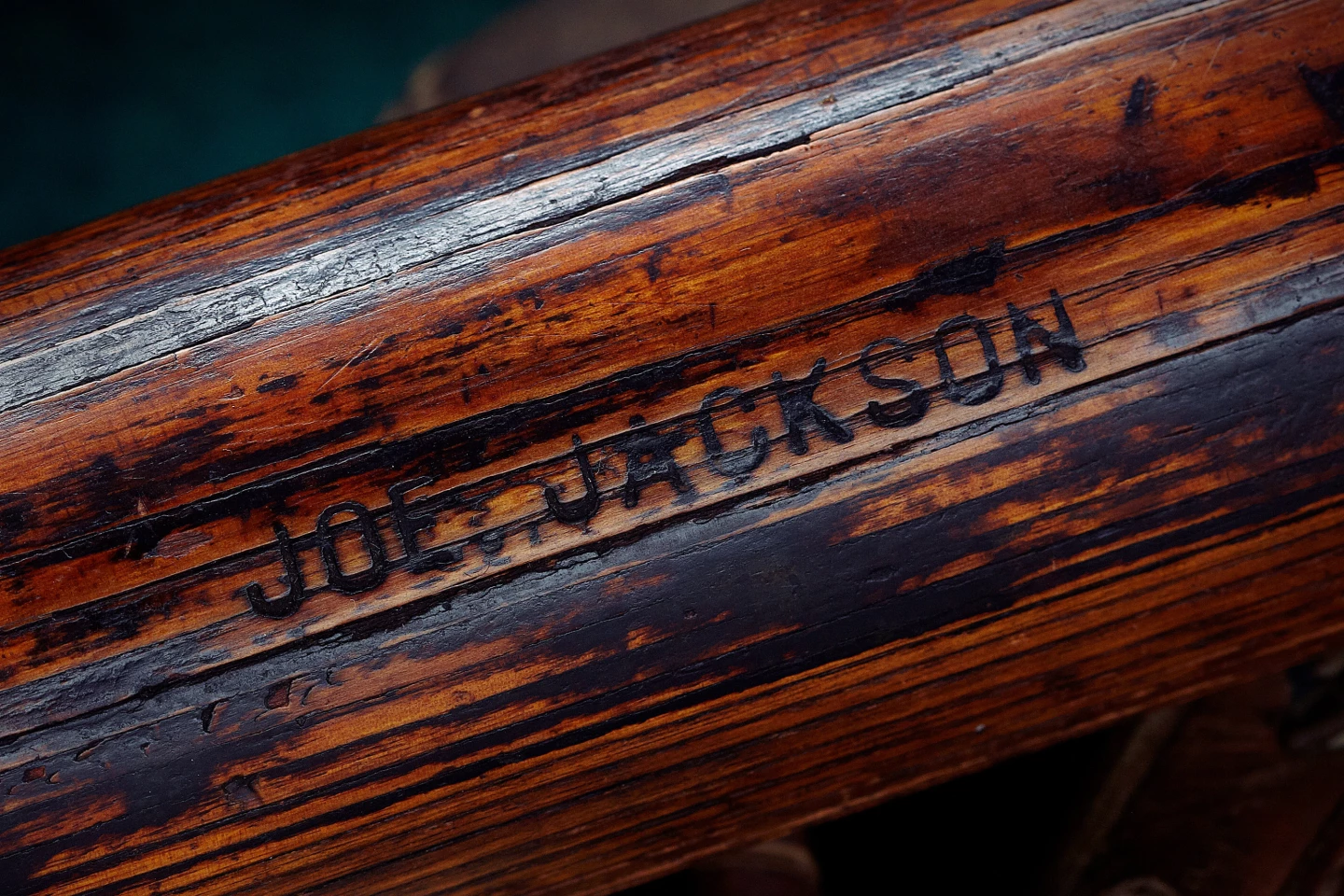
Price: $956,000
Game-used by: “Shoeless” Joe Jackson (Rookie Year)
Auction House: Heritage Auctions
Auctioned: February 23, 2014
Provenance (from the Heritage Auctions catalogue description): "Whenever I got the idea I was a good hitter, I'd stop and take a look at [Joe Jackson]. Then I knew I could stand some improvement." --Ty Cobb
It took the greatest scandal in the history of our National Pastime to redefine Joe Jackson. He had been, for the last full decade of the Dead Ball Era, simply the greatest hitter on the planet, a distinction assigned to him by those best able to do so, the men who aspired to the title themselves. But where legends like Cobb and Williams turned a scientific eye to the process, deconstructing that fragment of a second that separates success from failure into parts far too small for the mere mortal to see, Jackson's approach was far less cerebral. An illiterate child laborer from the rural South, he was the prototypical "natural," the beneficiary of a gift from God that would be invoiced with a debt of ignominy yet to be forgiven.
The approaching centennial of the Black Sox scandal has done little to quiet the debate over culpability, and compelling evidence of Jackson's innocence survives in his World Series stat line. Clearly the passage of ninety-five years has eliminated any hope for a definitive answer, a fact which then begs what is arguably the more pertinent question--is the game improved by this unyielding fidelity to Judge Landis' grudge?
Of course there are those who would argue that Jackson's athletic immortality is bolstered by his banishment, and clearly his position atop the the baseball collectibles market owes a debt, in practical terms at a minimum. A player of his stature would have been assured both Hall of Fame induction and the kind of ambassadorial role that would result in Old Timer Game appearances, coaching appointments and product endorsements of the sort that populates the hobby with autographs and relics from Ruth, Cobb and Wagner. For Shoeless Joe, the pickings are painfully thin.
And none could match the spectacular artifact we proudly present here, a signature model Hillerich & Bradsby that leading expert John Taube confirms to be "the only Joe Jackson bat in existence that is factory documented as being game used by Jackson during his Major League career." While this distinction alone would be more than enough to justify the claim, the factory sidewriting assigns use to the greatest rookie season in the Major League record books, the only one in history to conclude north of the fabled .400 mark.
The PSA/DNA letter of examination (and the MEARS letter that assigns an A9.5 rating) tout game use characterized as both "tremendous" and "significant," bearing witness to a remarkable productivity inclusive of an American League-leading 226 hits and twenty-six triples in 571 at-bats. Ball marks and cleat impressions coat the barrel, where minor grain separation likewise bears witness to the lumber's long and fruitful term of service. The knob is chipped at each side to a squared-off appearance. Two repaired cracks at the handle are surely what sent this bat into retirement, and off to the Hillerich & Bradsby factory for cloning as Jackson's favorite.
The right barrel was lightly planed in Louisville for the application of sidewriting, "Joe.Jackson" and the date of return. While the text has faded considerably over the passage of a century, all but the "o" in "Jackson" remains legible, as do the "6" for the month of June and "11" for the year. The day is faded beyond visibility, but the narrow space assures a single digit, thus a return date of June 1st through 9th, 1911. The "J.F. Hillerich & Son" center brand is correct for the 1905-1910 era, exactly what one would expect to see for a bat returned for reproduction in the middle of the 1911 season. Taube theorizes in his lengthy letter of examination that this bat was likely with Jackson from the very start of his Major League career, used with both the Philadelphia Athletics and Cleveland Naps during those thirty games of service prior to his official 1911 rookie season when it saw the bulk of its action. A block lettered "Joe.Jackson" imprinted on the barrel, and the "J13" vault marks at knob and barrel end, perfectly match the manner in which long-time Louisville Slugger employee and pro player representative Henry Morrow stamped returned bats for filing. All known Jackson bats in the PSA/DNA database derive from this J13 template. Length is thirty-five and a half inches, weight a hefty forty-two ounces.
But, of course, the importance and collecting appeal of a singular and seminal artifact from the career of "Shoeless Joe" Jackson is immeasurable, a fact which will remain unbelied even by the assignment of a sale price at the conclusion of bidding. It is, quite simply, one of the most significant articles of sports memorabilia available to the private collector, a status it will retain regardless of Jackson's future positioning in relation to baseball's good graces.
3 | 1929 Hillerich & Bradsby Baseball Bat,PSA/DNA GU 10
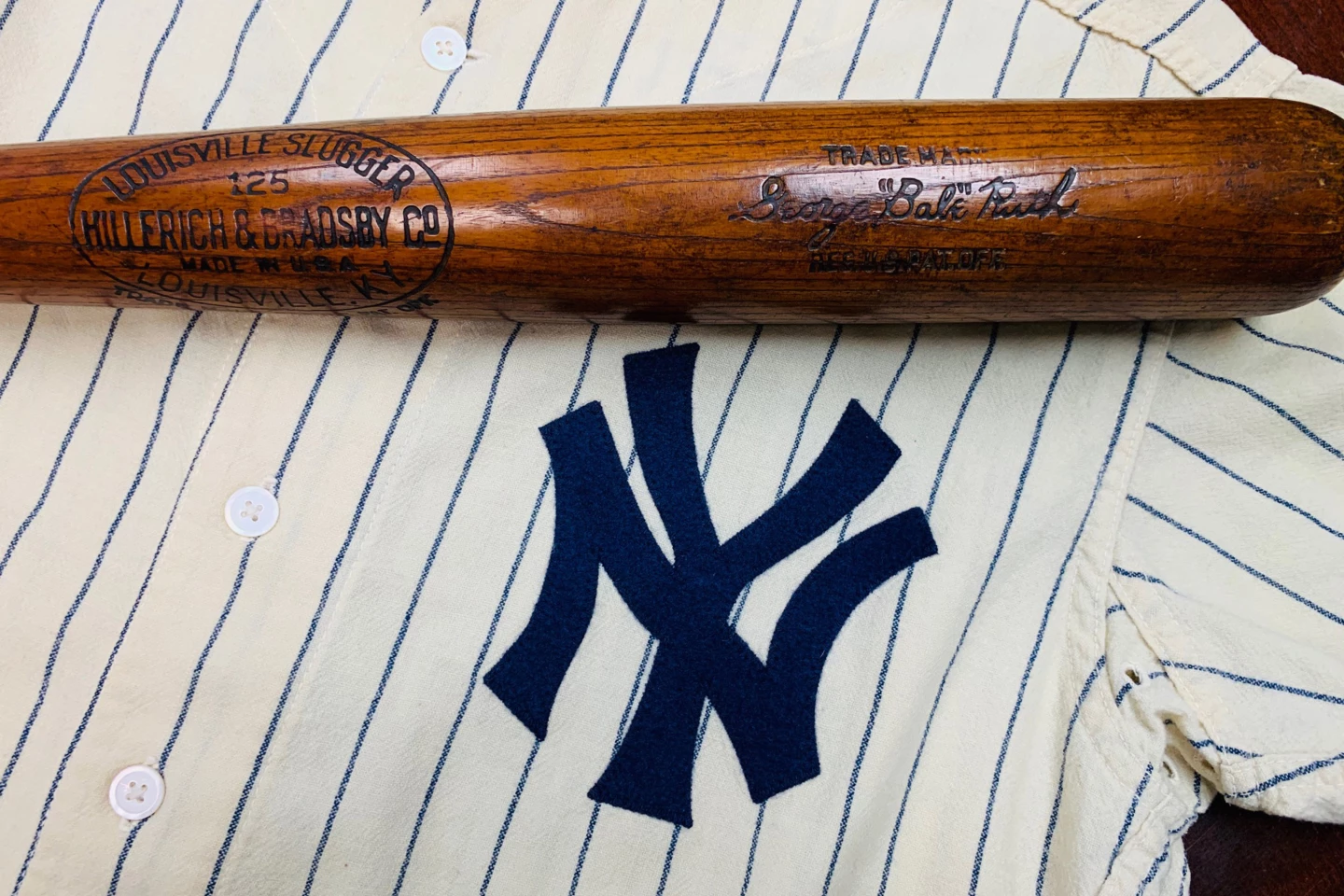
Price: $1,000,800
Game-used by: Babe Ruth (500th Home Run)
Auction House: SCP Auctions
Auctioned: December 14, 2019
Provenance (from the Sports Cards Plus catalogue description): "I swing big, with everything I've got. I hit big or I miss big. I like to live as big as I can." - Babe Ruth
George Herman "Babe" Ruth became the first player to reach the 500-homer plateau on August 11, 1929, establishing the career benchmark by which all power hitters are measured to this day. The bat Ruth used for that historic clout was gifted by him in the mid-1940s to his friend and former mayor of Suffern, New York, Jim Rice. Rice's family had quietly stored it for nearly 75 years until its unveiling here by SCP Auctions on the 90th anniversary of the The Babe's legendary milestone.
Babe Ruth played baseball like he lived life – with loud, gaudy, entertaining gusto. There was nothing subtle about the happy-go-lucky Sultan of Swat, who paraded through his career, forged an enduring relationship with adoring fans and then withstood the test of time as the greatest power hitter in baseball history. The prototype of the modern superstar, Ruth's unparalleled feats on the field were only equaled in magnitude by his gargantuan appetite for life away from the diamond. After being sold by the Red Sox to the Yankees in 1919, Ruth became the first player to hit 30, 40, 50 and 60 home runs in a single season as well as the first to top the 300, 400, 500, 600 and 700 marks. As Ruth biographer Robert Creamer asserted, "He practically invented the home run."
While Ruth's power-hitting exploits rewrote the record books, more than anything, the magnetic Babe is hailed as the savior of the game, the man who picked up our National Pastime by the bootstraps when it was mired in the bog of the 1919 Black Sox scandal and restored it to glory. In 1920, a year after hitting a Major League record 29 big flies, Ruth outhomered every MLB team but one with 54, singlehandedly putting an end to the Dead Ball Era and changing the very nature of the game and the way it was played. Ruth became an international icon as he powered his way through the Roaring Twenties and the Great Depression, continuing to post shocking home run totals of 59 (1921), 60 (1927) and 54 (1928) while anchoring one of the most devastating lineups in history (“Murderers’ Row”) and leading the Yankees to four World Series championships. By the start of the ‘29 season, Ruth had already belted 470 career home runs, nearly twice as many as the next closest (Cy Williams, 246). He was still only 34 years old, so the question wasn’t if Ruth would reach 500, but when.
On August 11, 1929, Babe Ruth stepped to the plate at Cleveland's League Park leading off the top of the second inning with a career tally of 499 on his stat sheet. (He had been hitting homers at a torrid pace, with four in his previous five games.) As the Bambino readied himself at the plate for his first at-bat of the game, Cleveland pitcher Willis Hudlin threw a high fastball "which left home plate much higher and ten times faster than it arrived," reported New York Times writer William Brandt. "It soared over the right-field fence near the foul line and was the first run of the afternoon."
According to the next day’s front-page, above-the-fold article in Cleveland’s The Plain Dealer, Ruth had called his shot before the game. In his story, Gordon Cobbledick wrote about an exchange the Yankees slugger had with the ballpark's security chief, H. Clay Folger: "Listen," said the Babe, "I'm going to hit No. 500 today and I tell you what I wish you'd do. I wish you'd find the kid who gets the ball and bring him to me. I'd kinda like to save that one."
The majestic flight of the ball saw it clear League Park’s 40-foot fence in right, land out of the stadium, and roll down Lexington Avenue where it was picked up by a lucky Indians fan named Jake Geiser. According to newspaper accounts from the period, Geiser was ushered to the Yankees dugout where Ruth slipped him $20 and a Babe autographed ball in exchange for the historic leather sphere. Given Ruth's keen awareness of the milestone ball, it stands to reason he placed equal, if not greater, importance on the bat he used that day. Number 500 coincided with Babe’s 30th of the season; he would finish with 46 to lead the league for the fourth straight year – a stretch that would reach six in a row and 12 of 14. It would take eleven more years before another man would reach 500 dingers when Jimmie Foxx achieved the vaunted mark during the 1940 season. Today, the whereabouts of Ruth's 500th home run ball is unknown; however, the bat he used to make history on that August 11, 1929 afternoon in Cleveland and the story of its journey are now revealed.
Although Babe Ruth enjoyed a level of fame in his day greater than that of any public figure in American history, he remained extraordinarily affable with fans, possessing an "everyman" quality that endeared him to all corners of society. Ruth enjoyed many interests outside of baseball and maintained many close friendships away from the game. Jim Rice of nearby Suffern, N.Y. – a small town some 30 miles from Manhattan – enjoyed a particularly close friendship with the Babe beginning in the early 1940s. For many years the pair regularly enjoyed golfing, bowling and dining together. Rice's exploits with Ruth are well documented in several newspaper articles from the period, including one reporting Jim's victory over Babe in a local bowling competition. There's even a note from the fellow who caddied for Ruth and Rice during one of their golf outings. Ruth became a frequent visitor to the Rice household, endearing himself to Jim's wife, Ethyl, and their children.
Rice was a semi-public figure himself who served as the mayor of Suffern for 16 years. Throughout their friendship, Babe bestowed numerous gifts upon the Rice family, including a photo inscribed to their daughter as well as other autographs and mementos. Most significantly, Ruth gifted this important milestone bat to Jim, identifying it as the one he used to launch his historic 500th career home run. The bat was impeccably preserved and carefully guarded in the Rice family for two generations encompassing 75 years. Hidden for decades from a world of collectors who treasure elite Babe Ruth artifacts above all else, Babe Ruth's 500th Home Run Bat is being introduced to the public here for the first time.
No single sports memorabilia item inspires more awe than a bat used by Babe Ruth. For veteran hobbyists or casual fans, the allure of a bat wielded by Ruth in his prime, the ultimate tool of his trade, is unfailing. While the total population of Ruth game bats known to exist today measures in the low hundreds, only a few possess a combination of historical importance and physical qualities that can be legitimately classified as museum-caliber. Not since SCP Auctions brought to market Babe Ruth's 1923 Yankee Stadium Opening Day Home Run bat in 2004 (sold for a record $1.265 million) have we seen a Ruth bat of near equal dynamics. Setting aside the bat's monumental historical importance of hitting number 500, its technical attributes, usage traits and overall aesthetic quality are extraordinary. The ash wood grain, rich amber coloration, and fine patina are marvelous. The deeply rendered factory center brand and barrel markings complete a perfect package of every desired attribute sought by fastidious bat collectors.
Per the Great Bambino's direct representation to their patriarch Jim, multiple generations of the Rice family always knew their heirloom to be the bat Babe Ruth used to hit his 500th homer. In 1993, Jim's wife Ethel wrote a note for her children and grandkids stating, "This baseball bat was given to my husband James R. Rice by Babe Ruth and told it was his 500 hundred [sic] Home Run bat." With no prior knowledge or exposure to the authentication and dating process of game-used bats, the Rice family submitted the bat to PSA/DNA’s renowned bat authenticator John Taube on February 14, 2018, as Babe Ruth's 500th homer bat along with Ethel's note. Taube's detailed analysis of the bat's usage traits, physical specs (length: 35.25", weight: 38.4 oz.), and year of manufacture (1928) wholly align with their astonishing assertion. Furthermore, Taube's letter, which can be viewed online, delivers a superlative-laden assessment of the bat's intrinsic qualities and ultimately a perfect PSA/DNA GU 10 rating.
Taube's letter points out several important details. Throughout his career, Babe would grip his bats with the H&B center brand turned away from him, leaving ball contact marks and grain swelling on the left barrel (above his branded name). In addition, he had a tendency to knock the dirt out of his cleats with the barrel of his bat, leaving cleat impressions. This bat holds strong evidence of both characteristics. In addition, Ruth would often use his bats a year after their order date. He liked to keep his favorite models for future use. Taube provides an example of a bat Ruth ordered in 1931 that he used in '32. The Babe's practice of gifting bats to friends or fans was a common occurrence as well. The fact that he kept his 500th HR bat for well over a decade before deciding to give it to Mr. Rice shows how much both this bat and this friendship meant to Ruth.
On behalf of the Rice family, it is with great pleasure and tremendous gratitude that SCP Auctions can share this historic bat and its story with the public. We are honored to participate in what we believe to be among the most singularly important discoveries in our field. Babe Ruth was a man of mythical proportions. More than any other athlete, he transcended sports, achieving a nearly unrivaled status as an American icon. Like the man himself, this bat is a national treasure.The bat is accompanied by an LOA from John Taube of PSA/DNA (graded GU 10), the aforementioned letter from the late Ethel Rice, as well as other articles of provenance. Three original newspapers from August 12, 1929 with headlines and articles documenting Babe's milestone home run are also included (New York Times, Chicago Daily Tribune, and Santa Fe New Mexican).
2 | 1922-23 Hillerich & Bradsby Baseball Bat, PSA/DNA GU 10

Price: $1,025,000
Game-used by: Lou Gehrig (sidewritten)
Auction House: Heritage Auctions
Auctioned: February 23, 2020
Provenance (from the Heritage Auctions catalogue description): "Although Hartford watches Gehrig go with regret," reported the Hartford Courant on August 30, 1924, "Local fans on the whole are delighted to see him make his way to the big show and will pull for him to develop into a genuine big leaguer." For the better part of two seasons the stocky first baseman had seen his fanbase swell at the Hartford Senators home park of Clarkin Field, where his prodigious home run clouts had earned him the nickname, "the Eastern Babe," after the Eastern League in which Hartford competed. In 504 plate appearances in 1924 prior to that telephone call from the Bronx, Gehrig had launched thirty-seven round-trippers while batting a sizzling .369 and slugging nearly one hundred points better than the next closest Eastern Leaguer.
Gehrig had enjoyed a brief, late-season debut with the 1923 World Championship team prior to his permanent call-up, hitting his first of 493 career home runs (and bringing home Babe Ruth for the first of dozens of times) on September 27th. Eighteen days later, he'd sign an endorsement contract with Hillerich & Bradsby, forever after receiving bats with his facsimile signature burnt into the barrel.
The absence of that facsimile signature on the barrel of the offered lumber establishes this as one of only two known pre-endorsement models from the Iron Horse, placing the enormously important relic into the legend's youthful hands as either a member of the Columbia University team, the Hartford Senators, the New York Yankees, or possibly all three. "Block lettered" bats were only issued by the H&B factory to athletes not under contract.
Factory sidewriting on the barrel of the battle-scarred truncheon reads, "40 oz., Lou Gehrig, 4-22-25," a date that falls just over a month short of the start of the Hall of Fame first baseman's legendary consecutive games streak. Its return on this date strongly suggests that at least some of the "heavy use" (as characterized by the experts at PSA/DNA) can be attributed to Big League play. Leading authenticator John Taube explains in his lengthy letter of examination that it was quite common for bats to see use years after its production date, providing a photo in the paperwork of Babe Ruth in 1932 holding a bat produced no later than 1930.
The earliest entry in H&B's factory ordering records for Gehrig dates to April 8, 1925, calling for a thirty-five and a half inch (35.5") "Old Hornsby" model weighing thirty-nine to forty ounces (39-40 oz.). Nineteen caliper readings on the subject bat perfectly match those specs, suggesting that this sidewritten gamer is the genetic forebear of Gehrig's earliest documented signature models.
The historic war club, one of the most significant bats Heritage has ever had the privilege to present to the collecting community, is uncracked and coated in ball marks and cleat divots. Remnants of the original shipping label affixed to send the bat back to Louisville for duplication is still visible. A bit of grain checking on back barrel speaks to thunderous power of a burly youngster on the brink of immortality.
1 | 1923 Hillerich & Bradsby Baseball Bat
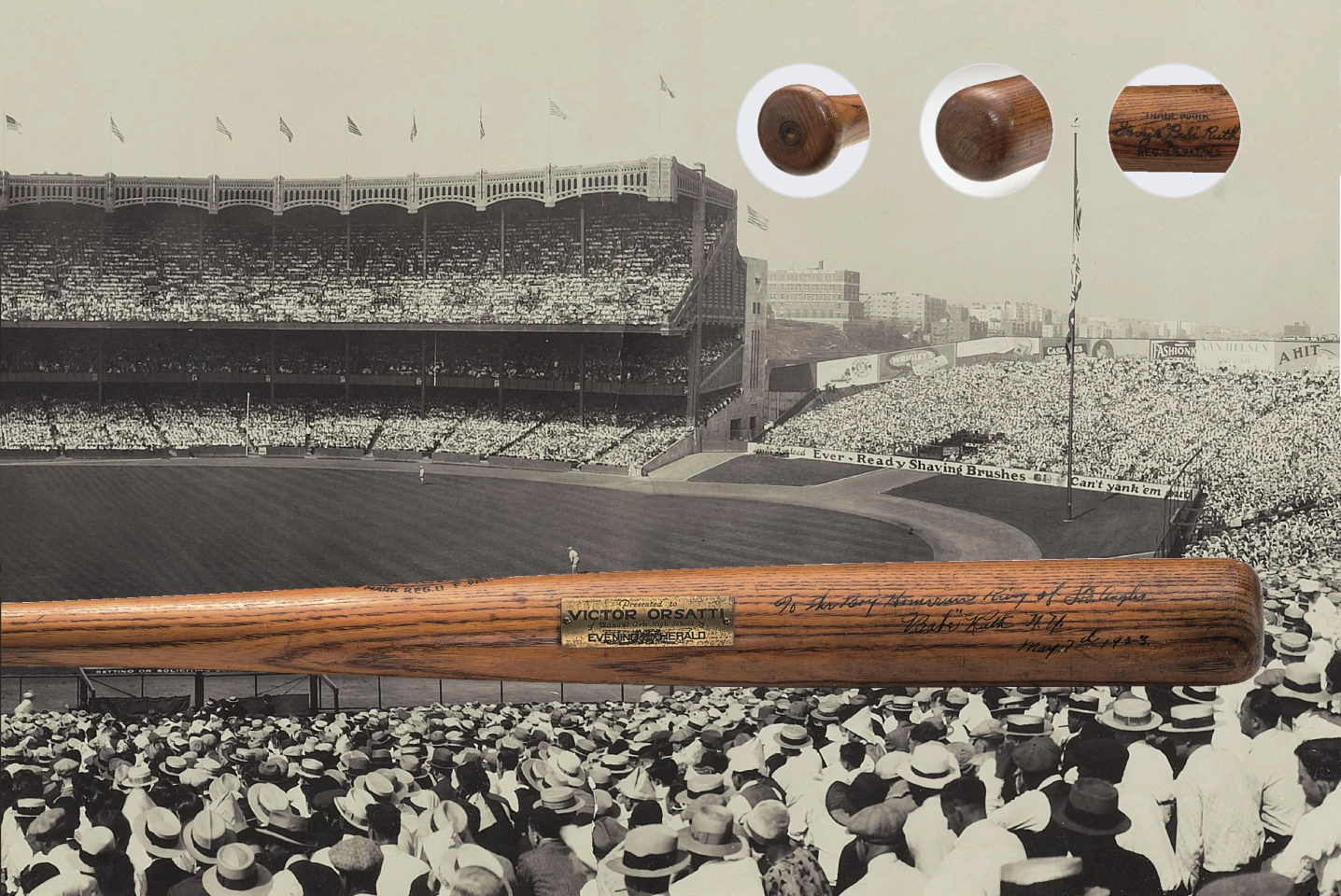
Price: $1,265,000
Game-used by: Babe Ruth in scoring the first home run of 1923 during the opening game at Yankee Stadium
Auction House: Sotheby’s/SCP
Auctioned: December 2, 2004
Provenance (from the Sotheby’s/SCP Auction Catalogue): As decades passed, Babe Ruth made many indelible marks in the annals of history. Hitting the first home run in Yankee Stadium would forever remain among the most prominent. Victor Orsatti himself would distinguish himself as a man of high accomplishment in the fields of sports and business. After a successful college career at USC, where he excelled in baseball, football, and track and field, Victor earned a major league tryout with the St. Louis Cardinals, where his brother Ernie was already a fixture with the team.
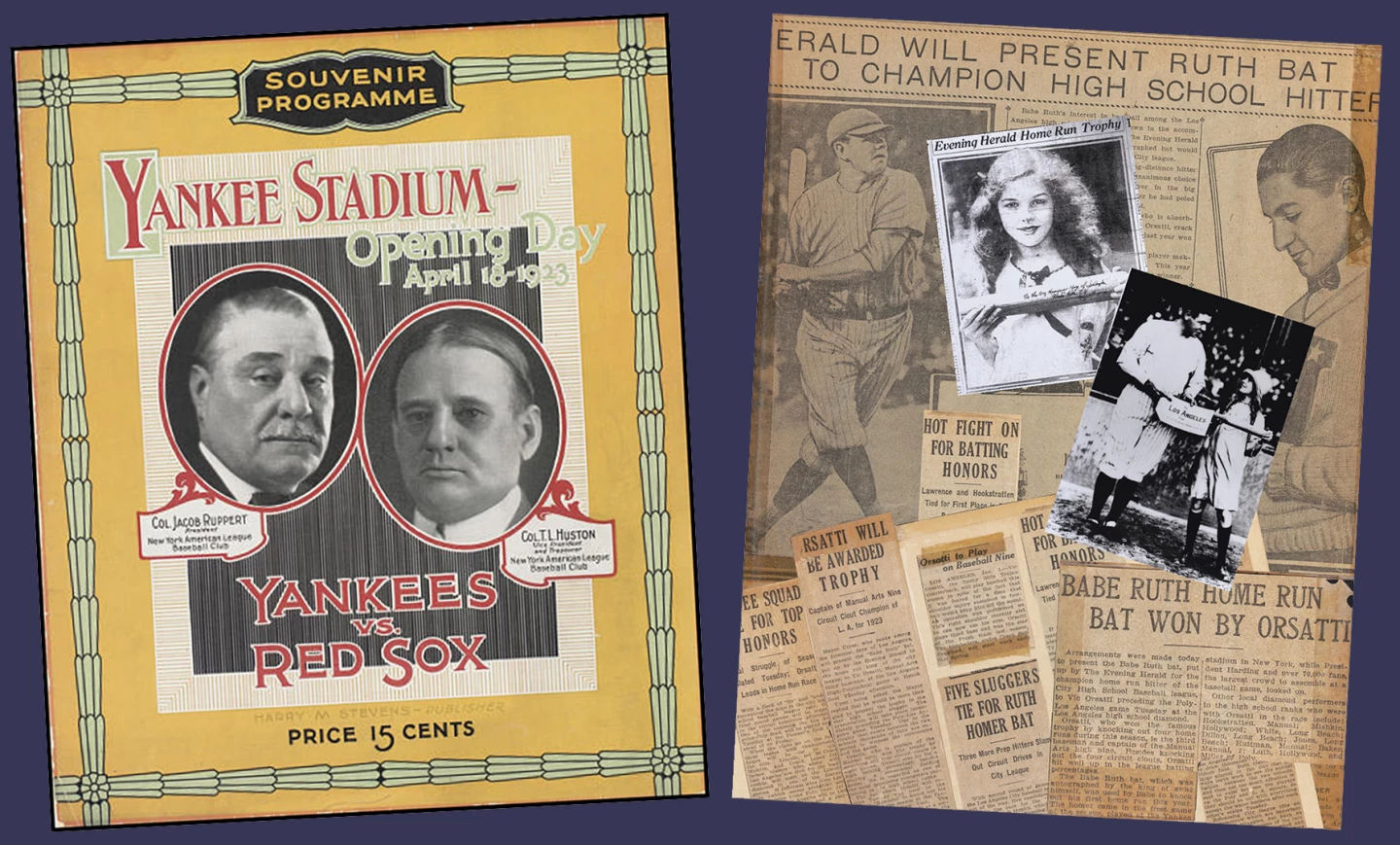
Of his own accord, Orsatti opted for a career in Hollywood, and in spite of his matinee idol looks, he made his mark off-screen as a successful talent agent. Among the many stars in his stable were Judy Garland, Betty Grable, Edward G. Robinson and Mickey Rooney and he was romantically linked to actresses Jean Harlow, Carole Landis, Linda Darnell, Jean Harlow and Peggy Knudsen. Orsatti became a well-known savant in Hollywood’s golden age. The bat, not forgotten, rested undisturbed for the better part of eighty years.
The twilight of Orsatti’s life was quietly spent in Newport Beach, California. A caretaker, whom Orsatti came to regard as family, joined him to share the last ten years of his life. Orsatti’s fondness for his companion was clearly demonstrated one day. Bed ridden, knowing his health was failing, he called her to him, and directed her towards the corner of a closet in his room. There she found a baseball bat along with an extensive scrapbook of accompanying articles. Upon Victor’s request she brought the items to his bedside where, with a twinkle in his eye, he recalled to her how he had won the greatest prize a young ball player could ever conceive.
The Boy Home Run King of Los Angeles passed away at the age of seventy-eight in 1984. Upon his death the autographed bat, used by Babe Ruth to hit the first Home Run in Yankee Stadium on its grand opening in 1923, and its accompanying articles, were bequeathed to his beloved caretaker.
When offered at auction in 2004 by Sotheby's/SCP, it was offered not just as a piece of sports memorabilia, but as one of the most singularly important discoveries in the realm of Americana.
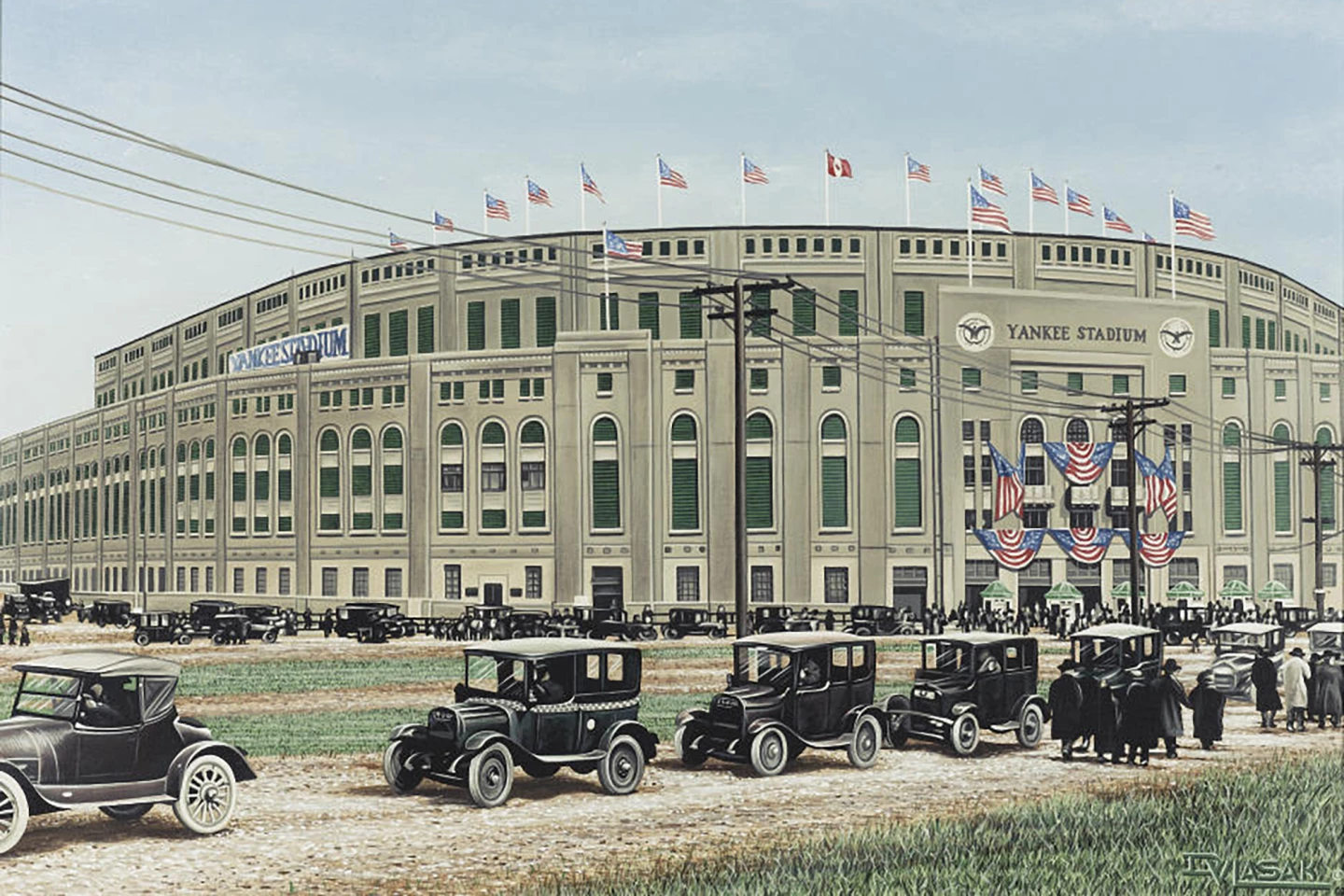
At the time of its opening in 1923, Yankee Stadium was a colossus. Tipped out of the stadium they shared with the Giants, the Yankees built a stadium for the ages. The new $2.5-million, triple-decker stadium in the Bronx held twice the crowd of any other ballpark in the country but the owners banked on being able to fill it with the drawing-power of Babe Ruth and they were proven correct.
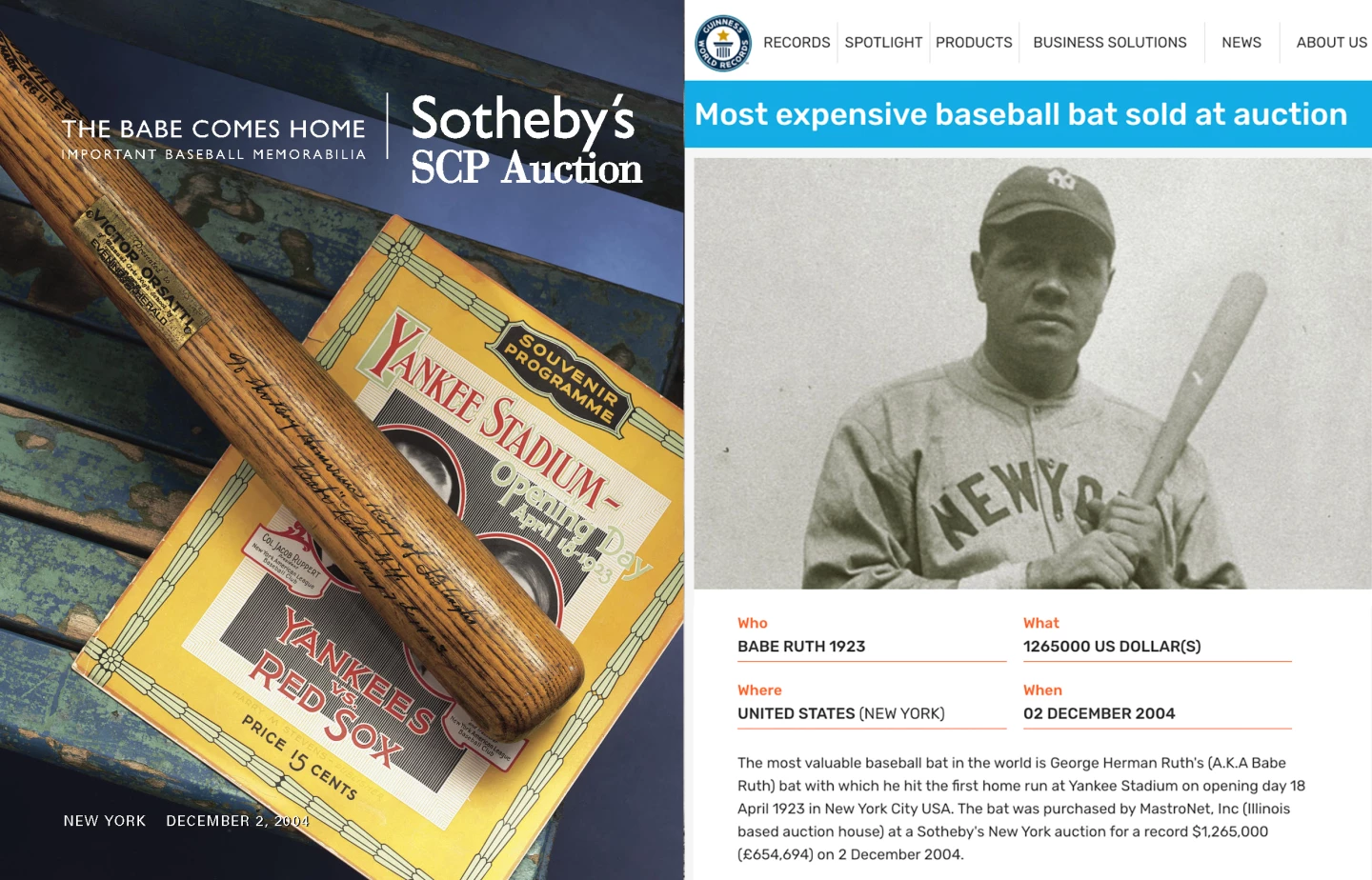
On opening day, beating the Boston Red Sox 4-1 in front of a crowd of 74,217. It was later revealed that Yankee Stadium had only 62,000 seats but the opening day crowd figure was never challenged. Babe Ruth's home run that day is one of the most famous events in American sporting history. The ball he hit was sold in 1998 for $126,500 and the bat was validated as the most valuable in history more than 15 years ago.
Babe Ruth was a man of mythic proportions. More than any other athlete, he transcended sports, achieving a nearly unrivaled status as an American icon. Like the man himself, this bat, the ultimate tool of his trade, is a treasure for the ages.
Mr. Orsatti's former caretaker continued in the spirit of Babe Ruth's inclination towards helping children, funding a baseball program at an orphanage in Mexico, where she spent a great deal of her retirement.
0 | 1923 Hillerich & Bradsby Baseball Bat, PSA/DNA, GU 10
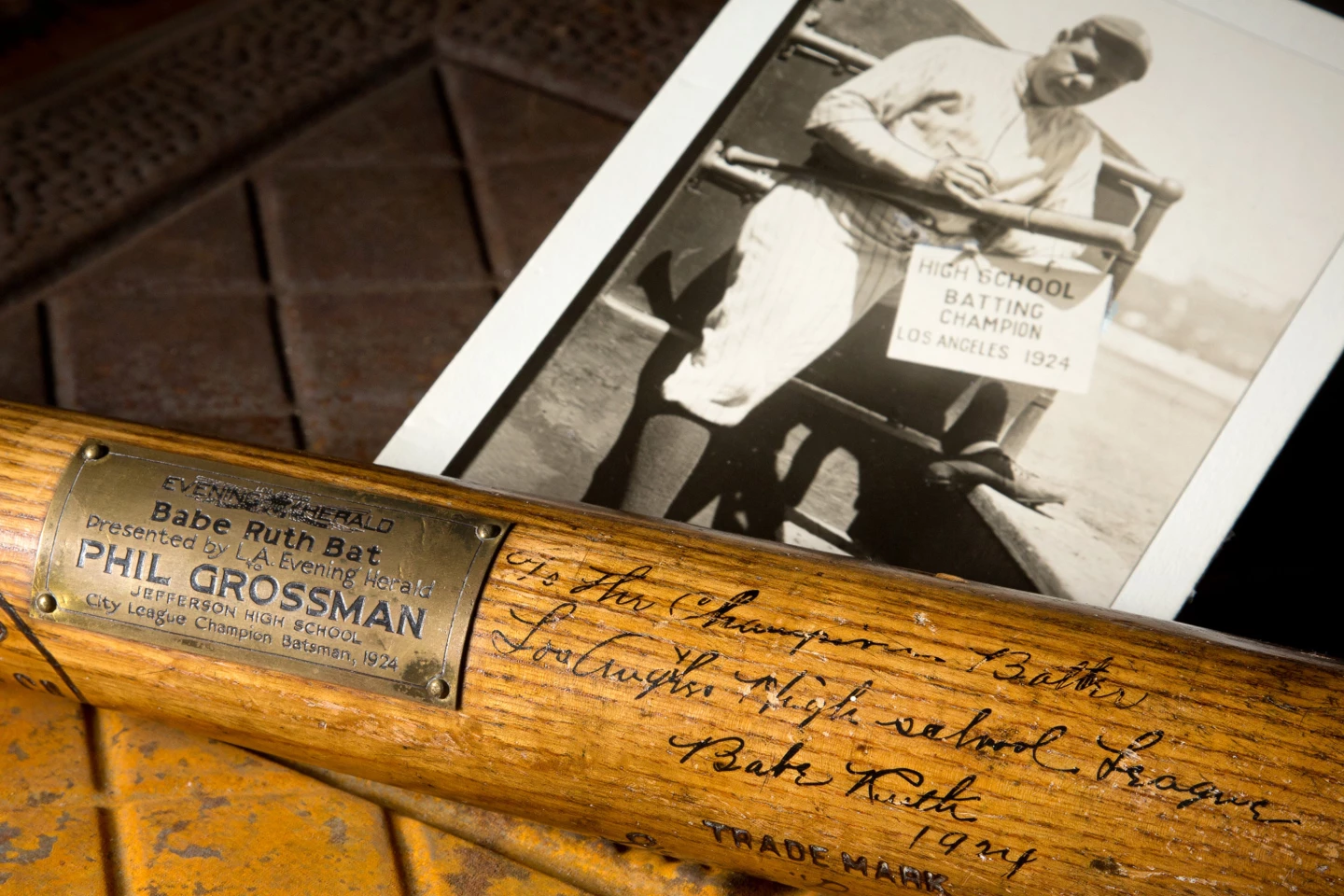
Price: failed to meet reserve price twice (estimated 2018 at $3.0+ million, estimated 2019 at $2.0+ million)
Game-used by: Babe Ruth
Auction House: 2018 at Mears, 2019 at Heritage
Auctioned: December 1, 2018 and February 24, 2019
Provenance (from the Mears and Heritage Auction Descriptions): This baseball bat has enough history for its own suspense novel, and we suspect there’s another chapter or two yet to be written.
The story of this bat goes back to 1923 when Babe Ruth’s marketing agent, Christy Walsh, created a three year promotional contest (1923-1925) for which a youth batting champion in the California area would receive an autographed bat which Ruth had used to hit his first home run of the season. Run in conjunction with the once-powerful but now-defunct Los Angeles Evening Herald, it was one of those contests which saw the entire city focus on the leaders in the batting table.
The inaugural contest winner’s bat, is the world-record bat which fetched $1,265,000 at auction in 2004 and was used by Ruth to hit the first homerun in old Yankee Stadium. If that bat were to reappear at auction today, it would doubtless fetch in excess of $10 million.
This bat was awarded to the batting contest winner in the second year (1924) of the agreement.The prize was anointed on April 20, 1924, at Griffith Stadium in Washington D.C.
On the mound was arguably the greatest pitcher of all-time, certainly of his time: The Big Train, Walter Johnson of the Washington Senators. Johnson would lead the league that season in wins, strikeouts, shutouts and ERA.
On this day, Ruth got a pitch he liked, loaded up on the back foot, lunged forward, released his hips, and sent his 36-inch Hillerich & Bradsbury arcing towards the ball with Bambino force. Ball met bat and an unmistakable sound echoed through the ballpark. If it looked like most of Ruth's blasts, it was a towering moonshot of a fly ball and necks strained to follow it through the air, and when it reached its apex it felt as though it hung there in space for a split second before lazily plummeting back into earth's atmosphere, landing well beyond the right field fence. It was his first home run of the 1924 season.
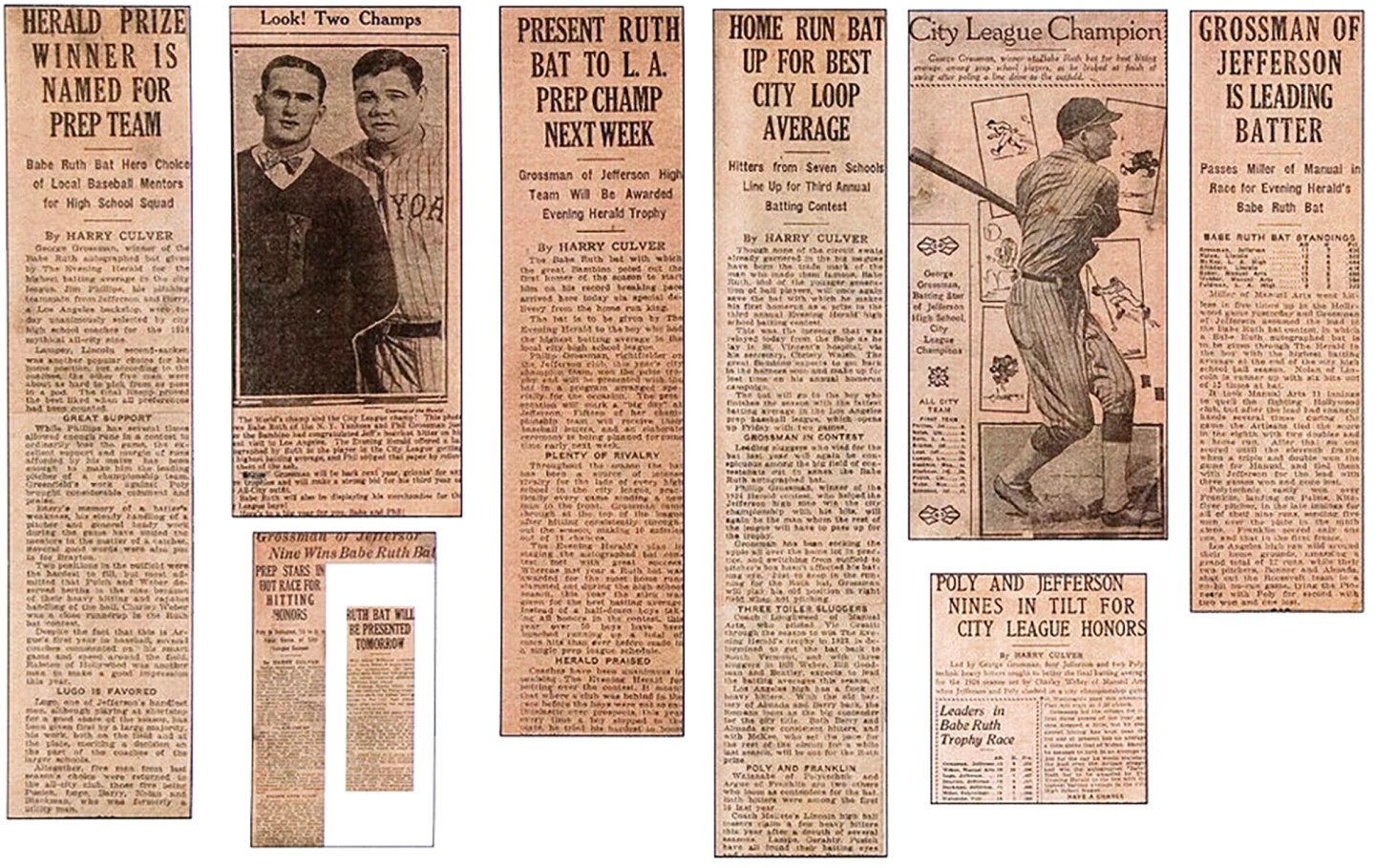
The bat was awarded to a young Phillip Grossman, with the bat became a family heirloom. Grossman had family in Bellevue, Washington, including a baseball-crazy young nephew named Mike Robinson. Mike's family would visit Los Angeles occasionally to visit Uncle Phil in his stucco home in the Hollywood Hills. Mike was only eight years old at the time, but he remembers that his uncle was tall and athletic, and that he always drove a nice car. And when he would arrive at the house, his uncle knew exactly what the boy wanted to see. "I'd come in the living room," Mike says now, "and the first thing he would do is go under the stairs and pull out his box of stuff. And all I cared about was looking at his stuff, and the bat, of course, was the cherry on top." It's easy to imagine a child trying to swing the massive, time-darkened Ruth bat, marveling at the inscription, running his fingers over the name and listening to his uncle tell the story of winning the batting title meeting the great Babe Ruth. “He loved telling that story,” says Mike.
In 1986, Grossman died. Mike, who was a 32-year-old man by this point, secretly hoped that his uncle's baseball collection would have been willed to him. It was not. Instead, the family held a family-only estate sale. Mike bid more than $3,000 for the bat, the scrapbook, the glove and the autographed ball. It was his. The sports memorabilia craze was just starting to gain traction in the 1980s, and by 1989 Mike wondered what exactly he was sitting on. Was his bat worth a lot of money? Hundreds of dollars? Thousands? A friend put him in touch with a man who was supposed to know about those kinds of things. He told Mike that he would take the bat to Los Angeles, that he knew people who could give him a price. Thinking back to that day, Mike hates to even speak the words. "So I said, 'Go ahead and take it down there and let me know what somebody's willing to offer for it and then I'll decide what I want to do with it.'"
The man left with the bat. Mike never saw him again and the Babe Ruth bat and his uncle's scrapbook were gone. Vanished. Stolen.
Mike went into business setting up home theater systems. He didn't see the bat again for a long, long time. Somewhere along the way he set up his cellphone with a Google Alert. If anything popped up involving Babe Ruth memorabilia being sold, he would get a notification. Hundreds of them came and went. There was never anything about his bat. It was as though his treasures had slipped away into the tangles of time itself, like the batting race of 1923 and The Babe and his Uncle Phil in Los Angeles.
And then, on his birthday in 2017, he got another alert on his phone. Today, as he tells the story, he is filled with wonder, as though he still can't quite believe what happened. "I opened it," he says, "and there was a picture of my bat."
There was a link to an article about the bat being put up for auction. The headline of the article said this: "1924 Babe Ruth Autographed First Home Run Bat - Could Become Most Expensive Piece of Memorabilia Ever Sold."
Mike says that when it all sunk in, he fell to the ground. And then he went to work. He called the FBI and got some advice. He hired a lawyer. He got the auction stopped. A court date was set.
The bat had been purchased by brothers George and Steve Demos. Their father had purchased it in 1989. The Demos brothers had done nothing wrong, neither had their father. Just as Phil Grossman’s bat meant the world to Mike Robinson, the Ruth bat represented something very special to George and Steve Demos. The boy’s parents divorced when the Demos brothers were very young. The elder Demos, Steve Sr. sought a practical means to continue to bond with his boys. Some fathers may have sought fishing or going to playing/attending baseball games as the means to spend time together, but for Steve Sr, he desired something with greater meaning. Steve Sr. was introduced to baseball at a young age where he attended Chicago White Sox games as a guest of family friend Ray Berres. Also of Greek heritage, the Demos family were close friends of Milt Pappas, together spending many nights in Chicago’s Greek town restaurant district sharing stories of baseball and family. For anyone that knew Steve Sr., conventional was not a word associated with the man. He had keen instincts for business, and saw the future value of game used baseball bats, always striving to collect the very best that were available. With a close relationship to early bat pioneer Dave Bushing, Steve Sr. built arguably the finest game used bat collection to have ever been assembled. But, his sons were not spoiled by their father’s business success or world class bat collection.
With each bat that was purchased, George and Steve were made to place the bats in tubes, tape the bottoms shut, create identification labels for each bat, and enter the bat, purchase price, and other pertinent information into a hand written spreadsheet. Then, repeatedly they were asked to learn dating era of the bat, manufacture, and use traits. Countless notes were taken and maintained for each bat, and the boy’s treated their collection like a stock portfolio. Value was not the driving force, but the bat collection taught the boys respect for the product and good business principles of how to take care of an asset.
Over the next thirty years, the brothers would continue to grow and maintain their collection, internalizing the lessons taught by father in hopes of providing his son’s the tools on how to survive in the world on their own. Sadly, in 2007 Steve passed away and left his life’s teachings and collection to his sons. Steve Sr. succeeded in using the game used bat collection as a tool and symbol on how to run a business.
Brothers and partners, George and Steve Jr. own and operate several successful franchises and businesses in northern Illinois and southern Wisconsin. Even with all of the wisdom passed from father to son, inexperience can miss out the detection of the presence of evil. From its use by Babe Ruth in 1924, awarding to Phil Grossman, ownership by Mike Robinson, purchase by Steve Demos Sr., the bat had one more custodian, John Rogers.
In an attempt to grow their business empire and sticking to the field they knew best, sports memorabilia, the Demos Brothers entered into an agreement with John Rogers, the man behind the world’s largest original photo empire. John Rogers owned the world’s largest private collection of photographs, using the business model of free digitization of photos for various newspapers.
With newspaper shifting from print to online readership, the papers no longer had the need for the original photos and the promise of a digitalized archive made good business sense. But instead of using the money generated from the sale of photos, the Daily news reported, “he used the money for personal and business expenses and to pay off other investors he had defrauded.” In a scheme so elaborate it was featured on the TV Show “American Greed,” the $3,000,000 sell price was never paid by Rogers and brothers had to negotiate to purchase the bat back.Once the bat was back, the Demos brothers decided to sell the bat, creating the google alert pinged by Mike Robinson. After pending litigation, judge decided there was only one fair thing to do: auction off the bat and split the proceeds between Mike Robinson and the Demos Brothers.
The legal proceeding guaranteed the new owner a clear title of ownership but as luck would have it, no-one stumped up the $3 million required to secure the bat at the Mears auction on December 1, 2018 and it was passed in.
The bat was subsequently sent to auction with Heritage Auctions with a lower $2 million estimate but once more it failed to sell. Just where the bat is right now we don’t know, though the recent flurry of activity at the top end of the market might lure it back to auction again and if it does sell, it will almost certainly set a new world record for a bat.



























